机电专业英语第2版8unit 8 Computer Numerical Controlled Machines.
(完整版)机电专业英语
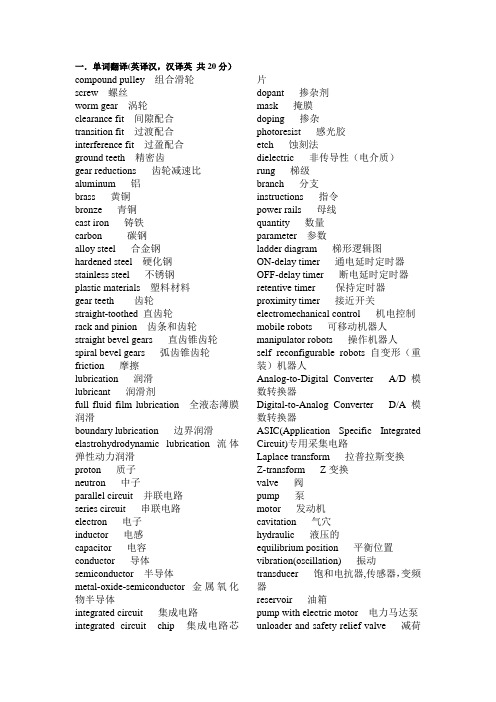
一.单词翻译(英译汉,汉译英共20分)compound pulley 组合滑轮screw 螺丝worm gear 涡轮clearance fit 间隙配合transition fit 过渡配合interference fit 过盈配合ground teeth 精密齿gear reductions 齿轮减速比aluminum 铝brass 黄铜bronze 青铜cast iron 铸铁carbon 碳钢alloy steel 合金钢hardened steel 硬化钢stainless steel 不锈钢plastic materials 塑料材料gear teeth 齿轮straight-toothed 直齿轮rack and pinion 齿条和齿轮straight bevel gears 直齿锥齿轮spiral bevel gears 弧齿锥齿轮friction 摩擦lubrication 润滑lubricant 润滑剂full fluid film lubrication 全液态薄膜润滑boundary lubrication 边界润滑elastrohydrodynamic lubrication 流体弹性动力润滑proton 质子neutron 中子parallel circuit 并联电路series circuit 串联电路electron 电子inductor 电感capacitor 电容conductor 导体semiconductor 半导体metal-oxide-semiconductor 金属氧化物半导体integrated circuit 集成电路integrated circuit chip 集成电路芯片dopant 掺杂剂mask 掩膜doping 掺杂photoresist 感光胶etch 蚀刻法dielectric 非传导性(电介质)rung 梯级branch 分支instructions 指令power rails 母线quantity 数量parameter 参数ladder diagram 梯形逻辑图ON-delay timer 通电延时定时器OFF-delay timer 断电延时定时器retentive timer 保持定时器proximity timer 接近开关electromechanical control 机电控制mobile robots 可移动机器人manipulator robots 操作机器人self reconfigurable robots 自变形(重装)机器人Analog-to-Digital Converter A/D模数转换器Digital-to-Analog Converter D/A模数转换器ASIC(Application Specific Integrated Circuit)专用采集电路Laplace transform 拉普拉斯变换Z-transform Z变换valve 阀pump 泵motor 发动机cavitation 气穴hydraulic 液压的equilibrium position 平衡位置vibration(oscillation) 振动transducer 饱和电抗器,传感器,变频器reservoir 油箱pump with electric motor 电力马达泵unloader and safety relief valve 减荷器和安全卸压阀check valve 止回阀accumulator 蓄电池valve manifold 阀箱electronic control card 电子控制插件cylinder 汽缸hydraulic motor 液压发动机return line filter 回油阀derivative 导数displacement 位移velocity 速度acceleration 加速度peak amplitude 振幅峰值digital signal processing 数字信号处理二、汉译英(20分)1.滑轮相比机器的缺点是使用刚性物体来传递力,滑动和伸展拉紧。
机械工程英语第二版part2unit8翻译加词组
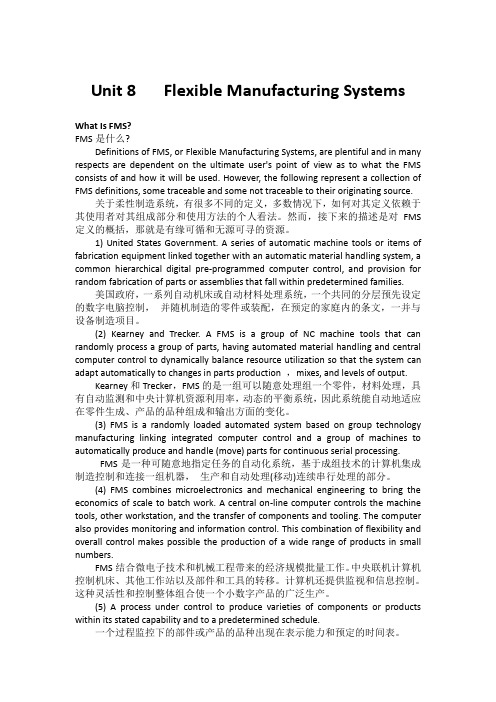
Unit 8 Flexible Manufacturing Systems What Is FMS?FMS是什么?Definitions of FMS, or Flexible Manufacturing Systems, are plentiful and in many respects are dependent on the ultimate user's point of view as to what the FMS consists of and how it will be used. However, the following represent a collection of FMS definitions, some traceable and some not traceable to their originating source.关于柔性制造系统,有很多不同的定义,多数情况下,如何对其定义依赖于其使用者对其组成部分和使用方法的个人看法。
然而,接下来的描述是对FMS 定义的概括,那就是有缘可循和无源可寻的资源。
1) United States Government. A series of automatic machine tools or items of fabrication equipment linked together with an automatic material handling system, a common hierarchical digital pre-programmed computer control, and provision for random fabrication of parts or assemblies that fall within predetermined families.美国政府,一系列自动机床或自动材料处理系统,一个共同的分层预先设定的数字电脑控制,并随机制造的零件或装配,在预定的家庭内的条文,一并与设备制造项目。
机械工程英语第二版全本书中英对照翻译

•Types of Materials材料的类型Materials may be grouped in several ways. Scientists often classify materials by their state: solid, liquid, or gas. They also separate them into organic (once living) and inorganic (never living) materials.材料可以按多种方法分类。
科学家常根据状态将材料分为:固体、液体或气体。
他们也把材料分为有机材料(曾经有生命的)和无机材料(从未有生命的)。
For industrial purposes, materials are divided into engineering materials or nonengineering materials. Engineering materials are those used in manufacture and become parts of products.就工业效用而言,材料被分为工程材料和非工程材料。
那些用于加工制造并成为产品组成部分的就是工程材料。
Nonengineering materials are the chemicals, fuels, lubricants, and other materials used in the manufacturing process, which do not become part of the product.非工程材料则是化学品、燃料、润滑剂以及其它用于加工制造过程但不成为产品组成部分的材料。
Engineering materials may be further subdivided into: ①Metal ②Ceramics ③Composite ④Polymers, etc.工程材料还能进一步细分为:①金属材料②陶瓷材料③复合材料④聚合材料,等等。
机电工程专业英语第2版
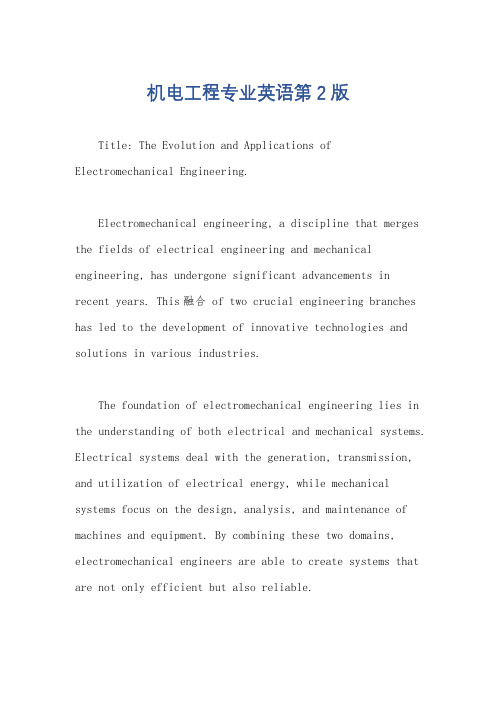
机电工程专业英语第2版Title: The Evolution and Applications of Electromechanical Engineering.Electromechanical engineering, a discipline that merges the fields of electrical engineering and mechanical engineering, has undergone significant advancements in recent years. This融合 of two crucial engineering branches has led to the development of innovative technologies and solutions in various industries.The foundation of electromechanical engineering lies in the understanding of both electrical and mechanical systems. Electrical systems deal with the generation, transmission, and utilization of electrical energy, while mechanical systems focus on the design, analysis, and maintenance of machines and equipment. By combining these two domains, electromechanical engineers are able to create systems that are not only efficient but also reliable.One of the most significant advancements in electromechanical engineering has been the integration of automation and robotics. With the increasing demand for precision and efficiency in manufacturing processes, the role of robots and automated systems has become paramount. Electromechanical engineers are responsible for designing and maintaining these systems, ensuring their seamless operation and optimal performance.Moreover, the integration of sensors and actuators has further enhanced the capabilities of electromechanical systems. Sensors are devices that detect and respond to external stimuli, while actuators convert energy into motion. By incorporating these devices into electromechanical systems, engineers can achieve precise control over various mechanical processes, leading to improved productivity and reduced waste.Another noteworthy advancement in electromechanical engineering is the increasing use of renewable energy sources. As the global focus shifts towards sustainable development, the integration of renewable energy systemsinto electromechanical designs has become crucial. Engineers are now exploring innovative ways to harness solar, wind, and other renewable energy sources, converting them into useful mechanical energy.In addition, the rising demand for smart and connected devices has also influenced the evolution of electromechanical engineering. The integration of sensors, actuators, and communication technologies into electromechanical systems has led to the development of smart devices that can communicate with each other and respond to external stimuli. This has opened up a wide range of applications in areas such as smart homes, smart cities, and工业自动化.Moreover, the increasing complexity of electromechanical systems has led to the development of advanced simulation and modeling tools. These tools allow engineers to simulate and analyze the behavior of electromechanical systems under different conditions, enabling them to predict and optimize their performance. This has significantly reduced the time and cost associatedwith the design and development of electromechanical systems.In conclusion, the evolution of electromechanical engineering has been driven by the increasing demand for efficiency, reliability, and sustainability. Theintegration of automation, robotics, sensors, actuators, renewable energy sources, and smart technologies has led to the development of innovative solutions in various industries. As technology continues to advance, the role of electromechanical engineers will become even more crucial in driving the development of efficient and sustainable systems.。
机电专业英语
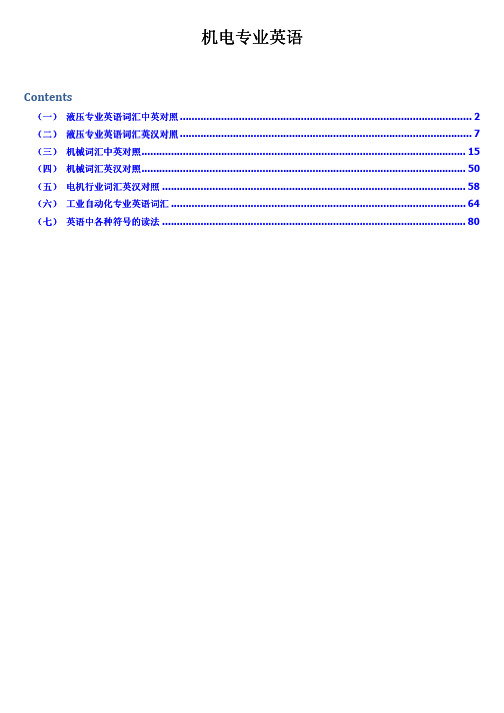
机电专业英语Contents(一)液压专业英语词汇中英对照 (2)(二)液压专业英语词汇英汉对照 (7)(三)机械词汇中英对照 (15)(四)机械词汇英汉对照 (50)(五)电机行业词汇英汉对照 (58)(六)工业自动化专业英语词汇 (64)(七)英语中各种符号的读法 (80)(一)液压专业英语词汇液压专业英语词汇中英对照中英对照1)安全回路 safety circuit / security control2)板式阀 sub-plate valve3)背压 back pressure4)泵的控制 control ofpump5)闭式回路 closed circuit6)闭式油箱 sealed reservoir7)避震喉 compensator8)便携式颗粒检测仪 portableparticle counter9)变量泵 variable displacement pump10)波动 ripple11)补液管路 replenishing line12)操作台 control console13)层流 laminar flow14)插装阀 cartridge valve15)差动缸 differential cylinder16)差动回路 differential circuit17)颤振 dither18)齿轮泵 gear pump19)充气压力 pre-chargepressure20)充油压力 charge pressure21)冲击压力 surgepressure22)出口节流回路 meter-out circuit23)出口压力 outletpressure24)传递函数 transfer function25)单向阀 check valve26)单向节流阀 one-way restrictive valve27)单作用缸 single-acting cylinder28)弹性密封件 elastomer seal29)底板 sub-plate30)底座安装 footmounting31)调速阀 speed regulator valve32)调速回路 flowcontrol circuit33)调压偏差 override pressure34)叠加阀 sandwich valve35)蝶阀 butterfly valve36)丁腈橡胶 nitrilebutadiene rubber ;nbr37)定位回路 position control38)对称度 symmetry39)额定工况 ratedconditions40)额定流量 rated flow41)额定压力 ratedpressure42)阀极性 valve polarity43)阀芯 valve element44)阀芯位置 valve element position45)阀压降 valve pressure drop46)法兰安装 flange mounting47)法兰接头 flange connection48)方向控制阀 directional valve49)方向控制回路directionalvalve control 50)防尘圈密封wiper seal;scraper51)防锈性 rust protection52)放气管路bleed line53)分辨率resolution54)分流阀flow divider valve55)峰值压力peak pressure56)幅值比 amplitude ratio57)负载压力induced pressure58)负遮盖 under lap59)复合密封件composite seal60)复现性 reproducibility61)刚度stiffness62)工步phase63)工作工步working phase64)工作管路workingline65)工作行程working stroke66)工作循环working cycle67)工作压力working pressure68)公称过滤精度nominalfiltration rating 69)公称压力nominal pressure70)功能图function diagram71)供给流量supply flow72)固定节流阀fixed restrictive valve73)固体颗粒污染solid contamination74)管卡 clamper75)管路flow line76)管路布置pipe-work77)过滤器压降filter pressure drop78)含水量 water content79)焊接式接头welded fitting80)耗气量 air consumption81)滑阀slide valve82)缓冲cushioning83)回路图circuit diagram84)回油管路returnline85)活塞杆密封rod seal86)活塞密封pistonseal87)机械控制式mechanically controlled type 88)机械密封mechanicalseal89)极限工况limited conditions90)集流阀 flow-combining valve91)减压阀pressure reducing valve92)接头fitting;connection93)截止阀shut-off valve94)进口节流回路meter-in circuit95)进口压力inletpressure96)径向密封radial seal97)静压力static pressure98)聚四氟乙烯polytetrafluoroethene;ptfe99)聚四氟乙烯polytetrafluoroethene;ptfe100)开口opening101)开启压力crackingpressure102)开式回路open circuit103)抗腐蚀性anti-corrosive quality104)可调节流阀adjustable restrictive valve105)空气处理单元air conditioner unit106)空气污染air contamination107)控制管路pilot line108)控制屏 control panel109)控制压力pilot pressure110)快换接头quick release coupling111)快进工步rapid advance phase112)快退工步rapid return phase113)扩口式接头flared fitting114)连续工况continuousworking conditions115)联轴器drive shaft coupling116)零偏 null bias117)零漂null drift118)零位 zero position119)零位内泄漏null quiescent leakage120)零遮盖 zero lap121)流道flow pass122)流量速度控制回路speed control123)流量极限flow limit124)流量控制阀flow control valve / flow valve125)流量系数flower factor126)流量增益flow gain127)流体传动hydraulic power128)流体逻辑元件图形符号symbols for fluid logic devices 129)逻辑功能图形符号symbols for logic functions130)脉冲发生器pulse generator131)密度density132)模拟放大器analogue amplifier133)膜片阀diaphragm valve134)内缩行程retract stroke135)内泄漏internal leakage136)耐压试验压力proofpressure137)排量displacement138)喷嘴挡板nozzle flapper139)漂移drift140)频率响应frequencyresponse141)平衡阀counterbalance valve142)普通阀commonvalve143)启动压力breakout pressure144)气囊式蓄能器bladder accumulator145)气穴cavitation146)气液技术hydropneumatics147)球阀global ball valve148)热交换器heat exchanger149)软管flexible hose150)闪点 flash point151)伸缩缸telescopic cylinder152)实际工况actualconditions153)实际输出力actual force154)手动式manually operated type155)输出力force156)数字放大器digital amplifier157)双筒过滤器duplex filter158)双作用缸double-acting cylinder159)顺序动作回路sequeunt circuit160)顺序阀sequence valve161)瞬态工况instantaneous conditions162)四通阀four-way valve163)伺服阀servo-valve164)梭阀 shuttle valve165)填料密封packing seal166)停止工步dwell phase167)同步回路synchronizing circuit / synchronise circuit 168)图形符号graphical symbol169)外伸行程extend stroke170)外泄漏 external leakage171)弯头elbow172)温度控制器thermostat173)紊流turbulent flow174)稳态工况steady-state conditions175)无杆端rear end176)吸入压力suctionpressure177)系统压力system pressure178)先导式pilot-operated type179)线性度linearity180)线性区 linear region181)相位移phase lag182)消声器 silencer183)泄漏 leakage184)泄油管路drain line185)卸荷阀unloading valve186)许用工况acceptable conditions187)旋转方向directionof rotation188)旋转密封rotary seal189)循环circle190)循环速度cycling speed191)压差计 differential pressure instrument192)压降pressure drop;differential pressure193)压溃压力collapsepressure194)压力表pressure gauge195)压力传感器electricalpressure transducer196)压力开关pressure switch197)压力控制阀pressure relief valve / pressure valve 198)压力控制回路pressure control circuit / pressure control199)压力-时间图pressure time diagram200)叶片泵vane pump201)液控单向阀pilot-controlled check valve202)液控式hydraulic controlled type203)液力技术hydrodynamics204)液体污染liquid contamination205)液位计 liquid level measuring instrument206)液压泵站power station207)液压放大器hydraulic amplifier208)液压辅件accessory209)液压缸cylinder210)液压回路circuit211)液压卡紧sticking212)液压马达hydraulic motor213)液压气动元件图形符号symbols for hydraulic and pneumatic components 214)液压锁紧hydraulic lock215)液压系统hydraulic system216)异径接头reducer fitting217)溢流阀pressure relief valve218)硬管rigid tube219)优先控制overridecontrol220)油口port221)油路块manifold block222)油雾气lubricator223)油箱容量reservoir fluid capacity224)有杆端rod end225)有效过滤面积effectivefiltration area226)阈值threshold227)运动粘度kinematicviscosity228)运行工况operating conditions229)运行压力operatingpressure230)噪声等级noise level231)闸阀gate valve232)粘度viscosity233)遮盖lap234)针阀needle valve235)正遮盖 over lap236)执行元件actuator237)直动式directly operated type238)滞环hysteresis239)中位 neutral position240)重复性repeat ability241)轴向柱塞泵axial piston pump242)柱塞泵 piston pump243)锥阀poppet valve244)自动循环automatic cycle245)自由位free position246)组合垫圈bondedwasher(二)液压专业英语词汇液压专业英语词汇英英汉对照1)abrasion 摩擦2)absorber 吸收器;吸收剂;过滤器;减震器3)accessories 辅件,附件,配件4)accumulate 储存;蓄能;累积5)accumulator 蓄能器;蓄电池;累加器6)actuated 操纵,控制7)actuator 执行元件;液压缸;马达8)adapter 接头;衬套;压环;连接件9)adjustable fittings/swivel nut 旋转接头10)admission 供给,供油,供气11)air bleed 排气阀12)air hole 气孔13)air release plug 排气塞14)alignment pin 定位销15)alignment 找正,定心,对中16)alternative motion 往复运动17)amplifier 放大器18)anti-extrusion ring 密封挡圈,挡圈19)argon 氩气20)asbestos pad 石棉垫21)assembly 组合,组件,机组22)axial piston motor 轴向柱塞马达23)back pressure valve 背压阀24)back support ring 后支承环25)back-flow 回流26)back-up ring 挡圈27)back-up 支撑28)banjo fittings 铰接式管接头29)banjo fittings 铰接式管接头30)barrel 桶,缸体31)base 底座;支座32)bearing ring 导向套33)bearing 支承;轴承;方位34)bed 台35)behavior 性能;工况36)bend loss 弯头损失37)bend 弯头;弯管38)bent axis axial piston pump 斜轴式轴向柱塞泵39)bent axis piston motor 斜轴式轴向柱塞马达40)bite type fittings 卡套式管接头41)blade incidence 叶片安装角42)blade loss 叶片损失43)blade 叶片44)bleed 排气45)bleeder 排气孔46)blind hole 盲孔47)block 块;封闭;块体48)body 体;缸筒;阀体,壳体49)bolt hole 螺栓孔50)bolt 螺栓;插销;螺杆51)booster pump 辅助泵,充液泵52)bose 胶管,软管53)boss 轮毂54)bottom 底;底部55)bracket 支架56)bubble-tight 气密的57)buffer 缓冲器,阻尼器58)bulk head fittings长直通管接头59)bush ing 套,导向套;衬套60)butt welding 对接焊61)bypass valve 旁通阀;溢流阀62)cam plate type axial piston motor 斜盘式轴向柱塞马达63)cam plate type axial piston pump 斜盘式轴向柱塞泵64)cap 帽,盖,罩,塞65)capacity 容量;功率;排量;流量66)cartridge valve block 插装阀块体67)cartridge valve 插装阀68)casing 套,壳,罩69)cavitate effect 气蚀效应70)cavitation 气蚀71)cavity 腔72)center valve position 阀的中间位置73)centering 中心调整,定心74)centrifugal pump 离心泵75)chamber 腔,室;容积;油腔;气腔76)chamfer 槽;倒角77)change valve 换向阀78)changement 换向机构79)characteristic 特性曲线;特征线80)charger 加载装置81)charging 充液;充压82)check valve 单向阀83)choke block 节流板84)choke 节流;节流口85)choking effect 节流作用86)chord 弦87)circlip 弹性挡圈88)clearance 间隙89)clog 阻塞;堵塞90)closed impeller 闭式叶轮91)cock 龙头92)coil impedance 线圈阻抗93)collar 圈;法兰盘94)connection 连接;连接管路;接头95)constant delivery pump 定量泵96)constant displacement motor 定量马达97)consumption 消耗量98)contamination 污染99)control loop 控制回路,调节回路100)cottar pin 开口销101)creep爬行102)cross joint 十字接头103)cushion collar 缓冲套104)cycloid rotor pump 摆线转子泵105)cylinder bottom 缸底;缸后盖106)cylinder end cap 缸端盖107)cylinder head cap 缸前盖108)cylinder head 缸头109)ddv-direct drive valve直动式伺服阀110)dead zone 死区111)debugging 排除故障;调试112)de-energizing of solenoid 电磁铁释放113)deflation 排气114)delivery 流量115)differential pressure amplifier 压差放大器116)differential pressure regulator 定差减压阀117)differential 差动的;微分的118)diffusion vane 导叶119)dipping process 槽式酸洗120)direct operated solenoid valve 电磁阀121)directional control block 多路阀,方向控制阀组122)directly actuated 直接操纵的,直接控制的123)displacement volume 排量124)displacement 压出;排出;排量;位移125)dither颤振电流126)double acting piston 双作用活塞127)double action vane pump 双作用叶片泵128)double rod piston 双杆活塞129)double throttle check valve 双单向节流阀130)dowel 定位销131)drained 泄油的132)dust ring 防尘圈133)duty 负载,功率;工况134)dynamic response 动态频响135)effect 作用;效应136)effective capacity 有效排量,实际排量137)elbow 弯头138)electro-hydraulic 电液的139)emulsion 乳化液140)entrap 困油141)escape 泄漏,逸出,排出142)etching 蚀刻;腐蚀143)exhaust 排泄;回油;144)extension 活塞杆缩回145)fastener 紧固件146)fatigue 疲劳147)feedback gain 反馈增益148)feedback 反馈149)female connector fittings接头螺母150)filler 加油口,注油口;填料;垫片151)flange joint 法兰式接头152)flat blade 平面叶片153)flow amplifier 流量放大器154)flow gain 流量增益155)flow regulating valve 调速阀156)flow saturation 流量饱和157)flow valve流量阀158)flow 流;液流;流程;流束;流量;流动159)flowline 管路;流线160)flow-regulator 流量调节阀161)fluctuation 脉动162)fluid 流体,液体;射流163)flushing冲洗164)forward inclined blade 前倾叶片165)four port valve 四通阀166)four position valve 四位阀167)frequency response 频率响应168)functional symbol 职能符号169)gain 增益170)gap 间隙,缝隙171)gas etching 气蚀172)gear casing 齿轮箱,变速箱173)gear pump 齿轮泵174)gear 齿轮,装置,机构175)geometric capacity 几何排量,理论排量176)governing 调节,控制177)grooved olive 迷宫密封环178)grout 灌浆179)guide blade 导叶180)hand operated valve 手动阀181)head 缸头,头部;盖;水头;扬程182)high pressure zone 高压区183)hollow piston 空心活塞184)housing 壳体;槽185)hub 毂;衬套186)hydraulic accessories 液压辅件187)hydraulic operated check valve 液控单向阀188)hydraulic operating fluid 液压油189)hydraulic package 液压泵站190)hydrostatic back-up 静压支撑191)hydrostatics 液压技术,液体静力学192)hysterics 滞环193)idling 空转194)impact 冲击,撞击195)impeller 叶轮196)incidence 入射;入射角197)incompressible fluid 不可压缩流体198)incompressible 不可压缩的199)inert gas welding 惰性气体焊200)inhibitor缓蚀剂201)inlet 进口;吸入202)intensifier 增压器203)intensity 强度204)jack柱塞缸;千斤顶205)jog 点动206)joint 接头;关节207)journal 轴颈208)jump 跳动;振动209)keyway 键槽210)lag 滞后;延迟211)laminar 层流的212)lap 滞后213)latch 插销;锁紧装置;锁定214)leak 漏;漏油;渗漏处;漏出物215)lifting lug 吊环216)line loss 管路损失217)linearity 线性度218)liner 衬套;导向套;内层胶219)liquid 液体的;液力的220)load 负载;载荷221)load-carrying ability 承载能力222)local pressure loss 局部压力损失223)locating collar 定位凸缘套224)location 位置;定位;安装225)lock 锁;闭锁;液压卡紧226)locking pin 锁紧销227)loop 环;环路;回路;循环228)loose collar 轴肩挡圈229)lost motion 空转230)low pressure zone 低压区231)lubricate 润滑232)lug 耳轴233)main loop 主回路234)mal stud fittings 端直通管接头235)malfunction误动作236)mandrel 心轴;芯棒237)manifold block 集成块238)manometer 压力机,压力表239)meter-in 进口节流240)meter-out 出口节流241)motor pedestal 电动机座242)motor 发动机,液压马达243)multi-stage pump 多级泵244)neutral position 中位;零位245)nfpa-national fluid power association 美国流体控制学会246)nitric acid柠檬酸247)nominal flow 公称流量248)nominal 额定的,公称的249)notch 凹槽250)nozzle flapper valve 喷嘴挡板阀251)null bias 零偏252)null 零位253)off-load 卸荷254)oil 油255)oiler 注油器256)olive 球面卡套257)open impeller 开式叶轮258)operation 运行;操作;运算259)orifice 小孔;节流孔260)overflow valve 溢流阀261)overload relief valve 安全阀;过载溢流阀262)pack 包,捆;组合件,部件,单元263)package包,捆;组件,单元264)packing 密封;密封装置;填料密封265)pad 衬垫;底座266)panel block 阀板组267)part 部分;零件;部件268)partial loss 局部损失269)partition 隔板270)passage 流道;通道;通过271)passivity 钝化272)pedestal 支座,底座273)phase lag 相位滞后274)phosphate ester hfd-r磷酸甘油酯275)pickling 酸洗276)piece 零件,部件277)pilot actuated 先导控制的,液控的278)pilot operated check valve 液控单向阀279)pilot valve先导阀280)piloted valve 先导式阀281)piloted 先导控制的282)pipe adapter 管接头283)pipe 管子,管道尤指铸铁管和钢管284)piston pin 活塞销285)piston 活塞;柱塞;阀芯286)pit 坑;槽287)pitch 节距288)pitting 凹痕;锈斑;点蚀289)plug 堵塞;阻塞;堵头290)plug-in 插入式的,组合式的291)poppet 提动阀芯,座阀芯,锥阀芯,碟形阀芯292)pore 孔;孔隙293)port 油口;连接口294)position feedback 位置反馈295)power pack 液压泵站296)power package 泵站297)pressure gain 压力增益298)pressure jump 压力突变299)pressure relief valve 压力溢流阀300)progressive flow渐增流量301)proportional pressure regulator 定比减压阀302)proportional valve 比例阀303)pulsation 脉动,波动304)pump body 泵体305)pump bracket 泵架306)pump casing 泵体307)pump impeller 泵叶轮308)pump shaft 泵轴309)pump test bed 泵试验台310)rabbet 球铰311)racing 空转312)rack 齿条;机架313)radial ball bearing 径向球轴承314)radial blade 径向叶片315)radial motor 径向马达316)radian 弧度317)rated flow 额定流量318)re-circulation循环319)rectifier plate节流板320)reducers extenders 变径管接头321)regulator 调节器,调压阀322)relief notch 卸荷槽323)relief 释压;溢流;卸荷324)restriction 节流;阻尼,节流口,阻尼孔325)restrictor 节流阀;节流口;阻尼孔326)retainer ring 卡环327)retract 活塞杆伸出328)reversal 反转,倒转329)revolution 旋转;转数330)rider 导向套331)rolling bearing 滚动轴承332)rotary knob 旋钮333)sandwich plate valve 叠加阀334)screwed joint 螺纹接头335)seal ring 密封圈;密封环336)seal 密封;封口;密封件;密封装置337)seizure 卡死,咬住,擦伤338)selector 换向阀339)servo loop 伺服回路340)servo valve 伺服阀341)servo-jet pilot valve 射流管阀342)servopump 伺服泵343)servovalve phase lag 伺服阀相位滞后344)shaft 轴345)single action vane pump 单作用叶片泵346)single-rod piston 单杆活塞347)sleeve 套;套管;卡套;阀套348)sliding bearing 滑动轴承349)sliding vane motor 叶片马达350)slope 曲线斜坡351)slot 缝,隙,槽352)socket welding 套管焊353)solenoid valve电磁阀354)static head 静压头355)stationary flow 定常流,定常流动356)stick-alip phenomenon 爬行现象357)straight pin 圆柱销358)streamline flow 层流359)stroke 行程360)sub-plate mount板式安装361)swing motor 摆动马达362)symmetry 对称性363)synchronized motion 同步运动364)synthetic lubricating oil 合成油365)tank body 箱体366)tee 三通接头,三通367)theoretic head 理论能头368)three position 三位369)threshold 灵敏度370)throttle valve / throttle节流;节流阀371)thrust bearing 止推轴承372)thrust collar 止推环373)total head 总能头374)trapping phenomenon 困油现象375)trapping 困油376)travel 位移;行程377)tube to tube fittings 接管接头378)tube to tube fittings接管接头union直通接管接头379)tube 管子尤指有色金属和无缝钢管380)tubeline 管路381)turbulent flow 紊流382)two position 二位383)union cross 四通管接头384)union elbow直角管接头385)union tee 三通管接头386)union 直通接管接头387)valve body 阀体388)valve pad 阀垫389)vane pump 叶片泵390)vane 叶片391)variable capacity pump 变量泵392)vent 放气;排气孔393)volume flow 体积流量394)washer 垫圈;衬垫395)water head 水头396)water-glycolhfc 水-乙二醇397)weld fittings焊接式管接头398)wiper 防尘圈(三)机械机械词汇词汇词汇中英中英中英对照对照1)一字螺丝批 slot type screwdriver2)一点透视 one-point perspective3)二合一黏合剂 epoxy resin adhesive4)二合胶;混合胶 epoxy glue5)二维的;平面的 two-dimensional6)二进制 binary7)二极管;整流子 diode8)二号螺丝攻 second tap9)二路开关 two-way switch10)十进制的;公制的 metric11)人工制品 artefact12)人造板 man-made board13)人体工程学 ergonomics; human engineering14)人体尺寸 human dimension15)人体测量学 anthropometry; anthropometrics16)刀片、刀身 blade17)刀具 tool18)刀具溜座 carriage19)刀柱 tool post20)刀架 tool rest21)刀架底座 tool rest bracket22)刀座帷;床鞍 apron23)刀座鞍;溜板座 saddle24)力三角形 triangle of force25)力平行四边形 parallelogram of force26)力多边形;多边形力学 polygon of force27)力的分解 force resolution28)力架;亮漆 lacquer29)力矩 moment30)力偶 couple31)力矩定律 law of moment32)力-距离图表 force-distance graph33)力图 force diagram34)力线 line of force35)力点 effort36)十字榫 cross halving joint37)十字螺丝 Philip's head screw38)十字螺丝批 Philip's type screwdriver39)丁字尺;T 尺 tee square40)三爪夹头 three-jaw chuck41)三角尺 set square42)三角形结构系杆 triangulation tie43)三角锉 triangular file44)三维的;立体的 three-dimensional45)三氯甲烷;哥罗芳 chloroform46)三聚氰胺;蜜胺 melamine47)三点透视 three-point perspective48)上油漆 painting49)上釉enamelling50)凡立水varnish51)叉形顶尖fork centre52)口罩mask53)士力;虫漆shellac54)士巴拿;扳手spanner55)大芯夹板;宽条芯夹板blockboard; solid corestock-laminated board 56)大量制造mass production57)子口刨;槽口刨;边刨rebate plane58)小型平槽刨miniature router plane59)小型线料弯曲器small wire bender60)小型弯折机mini bender61)小型电路断路器;跳菲miniature circuit breaker (MCB)62)小齿轮pinion63)山樟San Cheong64)工件workpiece65)工字梁I beam66)工作面working surface67)工作图;制作图working drawing68)工作台bench; working table69)工具tool70)工具贮存室tool storage71)工具槽well72)工具钢tool steel73)工场workshop74)工场安全workshop safety75)工程字书写技巧lettering76)工程系统engineering system77)工程绘图engineering drawing78)工业酒精;火酒methylated spirit79)弓形手钻;手摇曲柄钻brace80)弓形手钻嘴brace bit81)弓锯bow saw; hacksaw82)弓锯片hacksaw blade83)弓锯床hacksawing machine84)不平衡imbalance85)不含铁金属;非铁金属non-ferrous metal86)不贯穿孔;闭孔;盲孔blind hole87)不贯穿鸠尾榫lapped dovetail joint88)不对称asymmetry89)不锈钢stainless steel90)不稳定平衡unstable equilibrium91)中心centre92)中心线centre line93)中心冲centre punch94)中心钻centre drill95)中心钻嘴centre bit96)中央处理器central processing unit (CPU)97)中性neutral98)中性平衡;随遇平衡neutral equilibrium99)中性轴neutral axis100)中密度纤维板medium density fibre board (MDF)101)中粗锉纹second cut102)中碳钢medium carbon steel103)中线neutral wire104)互补金属氧化物半导体complementary metal oxide semiconductors (CMOS) 105)介子;垫片washer106)介指铁ring mandrel107)介电常数;电容率permittivity108)介稳态的;亚稳态的metastable109)内力internal force110)内卡尺inside calipers111)内能internal energy112)内涵性质intensive properties113)内圆弯凿scribing gouge114)内锁式配件interlocking fitting115)内燃机internal combustion engine116)内螺纹制造法tapping117)内螺丝internal thread118)内弯边concave edge119)六角金属枝hexagonal bar120)六角匙Allen key121)六角头螺丝hexagonal head screw122)公制的;十进制的metric123)公差tolerance124)冗余构件redundant member125)分力component force126)分子molecule127)分子力molecular force128)分切;分割;切断parting off129)分贝decibel130)分析analysis131)分析及批判学analytical and critical studies132)分析器analyzer133)分流器shunt134)分界面;界面;接口interface135)分厘卡micrometer136)分规divider137)分割车刀架parting tool holder138)分解decomposition139)分压器potential divider; voltage divider140)隔离开关isolating switch141)切削工具cutting tool142)切削液cutting fluid143)切削深度depth of cut144)切屑;碎屑chip145)切线锯法tangential sawing146)切辊纹;滚纹knurling147)切断;分切;分割parting off148)切断工具parting tool149)勾;勾脚hook150)勾刀;胶片?刀plastic cutter 151)化胶水tensol152)反向偏压reverse biased153)反相放大器inverting amplifier 154)反相器inverter155)反射reflection156)反电动势back e.m.f.157)反馈;回输feedback158)天拿水;稀释剂thinner159)天梯牙;齿条gear rack160)天然木材natural timber161)天然干燥法air seasoning162)孔隙率porosity163)尺寸dimension164)尺寸线dimension line165)尺身blade166)引力;重力gravitational force 167)心形凸轮heart-shaped cam 168)心材heartwood169)心轴mandrel170)心销core pin171)手工具hand tool172)手工锯junior hacksaw173)手削法paring174)手持虎钳hand vice175)手柄handle176)手套gloves177)手扫漆brushing lacquer178)手推车barrow179)手提式竖线锯portable jigsaw 180)手提电动工具portable power tool 181)手提电钻electric hand drill 182)手进给hand feed183)手摇曲柄钻;弓形手钻brace 184)手摇钻hand drill185)手锉hand file186)手锯;板锯handsaw187)手锥bradawl188)手辘轧机hand rolling machine 189)支柱;支撑物strut190)支架;支座support191)支点fulcrum; pivot192)文字text193)方向direction194)方向针pointing needle195)方枝square bar196)方波形square waveform197)方波产生器squarer198)方型牙板rectangular die199)方格纸;网格纸grid paper200)方通square tube201)方块图block diagram202)方锉square file203)方头钻嘴square shank bit204)方螺帽square nut205)方边凿;直边凿firmer chisel206)木wood207)木工woodwork208)木工工作间woodwork area209)木工工作台woodworker's bench210)木工车床wood turning lathe; woodworking lathe211)木工铅笔carpenter's pencil212)木工刨床thicknessing and planning machine213)木牙螺丝;木螺钉wood screw214)木材timber215)木材车削wood turning216)木材车削工具wood turning tools217)木屑压合板;万花板chipboard218)木条接榫corner strip joint219)木圆头槌doming mallet220)木模;模型patterns221)木线wood strip222)木胶粉ureaformal dehyde resin glue223)木锉rasp224)木螺钉;木牙螺丝wood screw225)木槌mallet226)止推轴承thrust bearing227)止推垫圈thrust washer228)比例proportion229)比例尺scale230)比例常数proportionality constant231)比例极限proportional limit232)比较器comparator233)比热容量specific heat capacity234)水平投影面horizontal plane235)水平仪;平水尺spirit level236)水气掣;漏电断路掣earth leakage circuit breaker (ELCB) 237)水晶胶;聚酯树脂polyester resin238)水晶胶的铸造成形resin casting239)水磨砂纸silicon carbide paper240)火叉firing fork241)火水;煤油kerosene242)火牛;变压器transformer243)火石轮grinder244)火花电蚀法;放电极加工electrical discharge machining 245)火酒;工业酒精methylated spirit246)火钳tongs247)火线;活线live wire248)火砖fire brick249)爪扣;爪形离合器;犬齿式离合器dog clutch250)牙板;丝模die251)牙板扳手;丝模扳手die holder (stock)252)牙板螺帽die nuts253)牛皮胶;动物胶animal glue254)牛油纸tracing paper255)牛顿运动定律Newton's laws of motion256)犬齿式离合器;爪扣;爪形离合器dog clutch257)丙烯?丁二烯苯乙烯acrylonitrile-butadiene-stryrene (ABS) 258)主轴;心轴spindle259)主题motif260)令(纸张的计数单位) ream261)凹座recess262)凹模hollowing block263)凸缘flange264)凸缘联轴节flange coupling265)凸轮cam266)凸轮式配件cam-action fitting267)凸轮传动cam drive268)凸头螺丝raised head screw269)加成作业;添加法addition process270)加油oiling271)加速器accelerator272)功能;用途function273)功率因子power factor274)功率放大器power amplifier275)功率板power amplifier board276)功率晶体管power transistor277)包氏记号法Bow's notation278)「包浩思」;「包豪斯」〈设计风格) Bauhaus279)半永固法;半永久接合semi-permanent joining280)半接榫halving joint281)半闭式槽榫stopped housing joint282)半圆(木)锉half-round rasp283)半圆车刀turning gouge284)半圆锉half-round file285)半圆头铆钉snap rivet286)半导体semiconductor287)卡路里;卡(热量单位) calorie288)卡纸card paper289)卡尺;测径器calipers290)去角;倒角chamfer291)可切削性machinability292)可行性feasibility293)可逆过程reversible process294)可压缩性compressibility295)可变电阻variable resistor296)四分仪quadrant297)四爪夹头four-jaw independent chuck298)四圆心法(绘图) four-centre method299)外卡尺outside calipers300)外形塑造shaping301)外形线;轮廓线outline302)外推法extrapolation303)外圆弯凿firmer gouge304)外螺纹external thread305)外螺纹制造法threading306)外弯边convex edge307)外观appearance308)失真distortion309)尼龙;聚醯胺nylon; polyamide (PA)310)尼龙墨水针笔technical felt-tip pen311)左右调校杆lateral adjusting level312)市售尺寸;标准尺寸stock size313)市电频率;电源频率mains frequency314)平(木)锉flat rasp315)平水尺;水平仪spirit level316)平行投影parallel projection317)平行车削parallel turning318)平行虎钳parallel vice319)平行钉法parallel nailing320)平底弯刨flat faced spokeshave321)平底钻嘴forstner bit322)平板结构slab construction323)平流扼流圈;滤波扼流器smoothing choke 324)平流电容器;滤波电容器smoothing capacitor 325)平流电路;滤汳电路smoothing circuit326)平面板;正台surface plate327)平面图;俯视图plan328)平面锤flatter329)平移translation330)平搭榫corner halving joint331)平嘴钳flat nose pliers332)平槽刨router plane333)平衡balance; equilibrium334)平衡力equilibrant335)平衡条件equilibrium condition336)平衡电桥balanced bridge337)平头弧刀square nose gouge338)幼纹smooth cut339)打凹成形hollowing340)打凸成形raising341)打槽机routing machine342)打线;打槽routing343)打磨fitting; polishing344)打磨机polisher345)本生灯Bunsen burner346)本征半导体intrinsic semiconductor347)正反器;触发器;复振器flip-flop348)正反馈;正回输positive feedback349)正火normalizing350)正向偏置forward bias351)正投影orthographic projection352)正投影图orthographic drawing353)正弦波形sinusoidal waveform354)正面投影front projection355)正视图elevation; front elevation356)正极;阳极anode357)正齿轮spur gear358)正台;平面板surface plate359)永久性接合permanent joining360)瓦通纸;瓦楞纸板corrugated board361)生长层cambium layer362)生产图production drawing363)生胶浆rubber cement364)生钢;铸钢cast steel365)生铁;铸铁cast iron366)用途;功能function367)白杨木poplar368)白胶浆PVA glue; white glue369)皮沙垫leather sandbag370)皮革leather371)皮革黏合剂leather glue372)皮鞋leather shoes373)目录contents374)矢量;向量vector375)石灰岩limestone376)石英晶体振荡器quartz crystal oscillator 377)石棉asbestos; asbestus378)石膏Plaster of Paris379)示波器oscilloscope380)立体图pictorial drawing381)交流电流alternating current (a.c.)382)交流电压a.c. voltage383)交联结构cross-linked structure384)仿饰金gilding metal385)伏特volt386)光力架clear lacquer387)光拉软钢bright drawn mild steel (B.D.M.S.) 388)光敏电阻light dependent resistor (LDR) 389)光测弹性学photoelasticity390)光刨;滑刨smoothing plane391)光电效应photoelectric effect392)光泽lustre393)全闭式槽榫closed housing joint394)共面力coplanar force395)共聚合作用co-polymerization396)共聚物copolymer397)共价键covalent bond398)共振;共鸣;谐振resonance399)印刷电路板printed circuit board (PCB)400)同素异形allotropy401)同轴电缆coaxial cable402)同温equality of temperature403)向量;矢量vector404)向量和vector sum405)合力resultant force406)合口扁钳close mouth tongs407)合成色;等和色secondary colour408)合成品composite409)合成粅料composite material410)合金alloy411)合金工具钢alloy tool steel412)合钉;定位销dowel413)回火tempering414)回复力restoring force415)回复力偶restoring couple416)回弹resilience417)回输;反馈feedback418)地线earth wire419)多刃切削刀具multi-point cutter420)多孔塑料;泡沫塑料;海绵状塑料foam plastics 421)多方榫接合pinned joint422)多媒体multi-media423)多晶性polycrystallinity424)多谐振动器;多谐振荡器multivibrator425)多边形力学;力多边形polygon of force426)字母冲letter punch427)字板letter stencil428)安全safety429)安全守则safety rule430)安全系数safety factor431)安全措施safety precaution432)安全眼罩safety goggle433)安全设备safety equipment434)安全药箱safety box435)安培ampere436)安培计;电流表ammeter437)尖脚spur438)年轮annual ring439)成本cost440)成形forming441)扣件;击固件fastener442)扣钉clout nail; cramp443)托架bracket444)收缩shrinkage445)曲柄crank446)曲柄轴crank shaft447)曲线规;云板;云尺French curve448)有效的efficient。
机电一体化专业英语复习
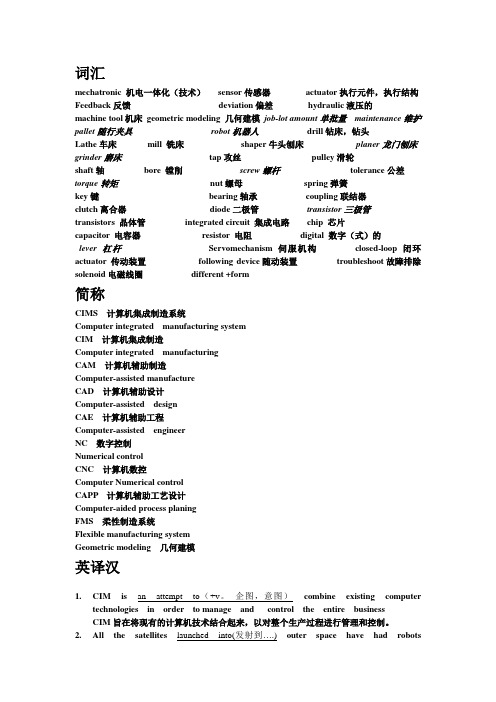
词汇mechatronic 机电一体化(技术)sensor传感器actuator执行元件,执行结构Feedback反馈deviation偏差hydraulic液压的machine tool机床geometric modeling 几何建模job-lot amount单批量maintenance维护pallet随行夹具robot机器人drill钻床,钻头Lathe车床mill 铣床shaper牛头刨床planer龙门刨床grinder磨床tap攻丝pulley滑轮shaft轴bore 镗削screw螺杆tolerance公差torque转矩nut螺母spring弹簧key键bearing轴承coupling联结器clutch离合器diode二极管transistor三极管transistors 晶体管integrated circuit 集成电路chip 芯片capacitor 电容器resistor 电阻digital 数字(式)的lever杠杆Servomechanism伺服机构closed-loop闭环actuator 传动装置following device随动装置troubleshoot故障排除solenoid电磁线圈different +form简称CIMS 计算机集成制造系统Computer integrated manufacturing systemCIM 计算机集成制造Computer integrated manufacturingCAM 计算机辅助制造Computer-assisted manufactureCAD 计算机辅助设计Computer-assisted designCAE 计算机辅助工程Computer-assisted engineerNC 数字控制Numerical controlCNC 计算机数控Computer Numerical controlCAPP 计算机辅助工艺设计Computer-aided process planingFMS 柔性制造系统Flexible manufacturing systemGeometric modeling 几何建模英译汉1.CIM is an attempt to(+v。
机电专业英语教案

A:Do you remember what EMF is?
B: It's short for electromotive force.
A: Pardon me? Would you explain it in detail?
B: I'm sorry. I have no time right now. Look it up in the next, I believe you will find the answer.
教学时间:
教学班级:
教学内容:
I.专业词汇
resistance阻力,电阻impede阻力,阻碍
represent描绘,代表ohm欧姆
element要素,元件resistor电阻器
thermistor热敏电阻diode二极管
series串联parallel并联
die渴望,死亡in unit of以...为单位
4. The formula I= , where I means current in amperes.
IV.对话
A: Excuse me, Peter?
B: Yes, Roger?
A: Could you tell me the unit of current?
B: Sure, the unit of current is ampere.
B: Well, a network can be regarded as a combination of more than one circuit.
A: Oh, I think I got it. Thanks.B: You're welcome.
作 业
会读认知新的专业词汇和术语。
机械工程英语第二版(叶邦彦 陈统坚主编)第二部分书后翻译
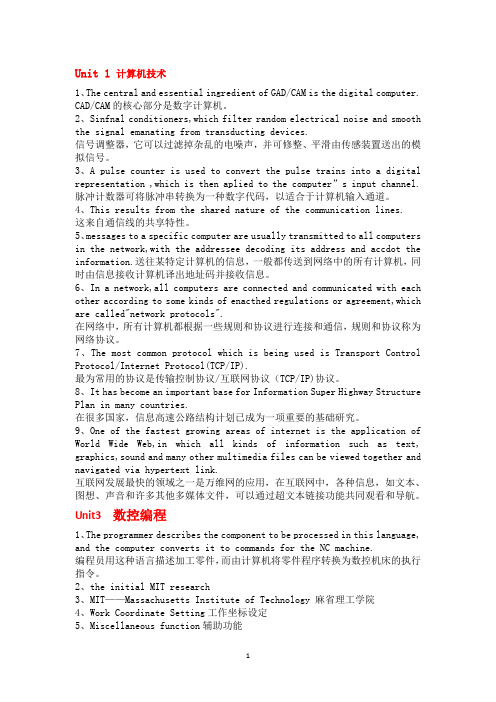
Unit 1 计算机技术1、The central and essential ingredient of GAD/CAM is the digital computer. CAD/CAM的核心部分是数字计算机。
2、Sinfnal conditioners,which filter random electrical noise and smooth the signal emanating from transducting devices.信号调整器,它可以过滤掉杂乱的电噪声,并可修整、平滑由传感装置送出的模拟信号。
3、A pulse counter is used to convert the pulse trains into a digital representation ,which is then aplied to the computer”s input channel. 脉冲计数器可将脉冲串转换为一种数字代码,以适合于计算机输入通道。
4、This results from the shared nature of the communication lines.这来自通信线的共享特性。
5、messages to a specific computer are usually transmitted to all computers in the network,with the addressee decoding its address and accdot the information.送往某特定计算机的信息,一般都传送到网络中的所有计算机,同时由信息接收计算机译出地址码并接收信息。
6、In a network,all computers are connected and communicated with each other according to some kinds of enacthed regulations or agreement,which are called"network protocols".在网络中,所有计算机都根据一些规则和协议进行连接和通信,规则和协议称为网络协议。
计算机专业英语单词

计算机专业英语单词**Unit 1 the development of computer technologyApprentice学徒n. Numerical数字的a. Integrator积分器n.Installation安装n. Semiconductor半导体n. Numerical数字的a. Share份额n.Mainframe主机n. House给…提供住房v. Stride进步n.Component元件n. Chip芯片n.Miniature微小化v. Circuit电路n.Kit一套n.Hurdle困难n.Simplify简化v.Drop-out辍学n.Fledgling刚刚起步的a. Unprecedented前所未有的a. Spreadsheet电子表格n. Automate自动化v. Band结合v.(与together连用)Novice初学者n.Abruptly突然地ad. Dub配制v.Prestige声望n.Fad时尚n.Retrieve检索v.Legitimate合法的a.**unit 2 computer systemComponent构建n. Calculation预料n. Payroll工资单n. Balance平衡vt. Chequebook账本n. Vary变化v.Diagram图解,图表n. Motherboard主板n. Memory内存n.Storage存储n.Data数据n.Process处理v. 处理过程n. Megabyte兆字节n. Floppy软盘n.Permanent永久性的a. Character字符n.Removable可移动的a. Command指令n.Keyboard键盘n.Remote遥控的a.Monitor监控器,显示器n. Display显示v.Text文本n.Graphical图表的a. Image图像n.Screen屏幕n.Feature(以…为)特征v. Resolution 分辨率n. Co-ordinate坐标n. Refresh刷新v.Specify列举v.Flicker闪烁v.Mouse鼠标n.Invert倒转v.Trackball轨迹球n. Button按钮n.Update改动v.Movement位移n.Printer打印机n.Available可用的a. Modem(modulator/demodulator)调制解调器n.Via通过,以…为媒介prep.**Unit 3 floppy drivesFloppy软磁盘 n. Drive驱动器n.Head磁头n.Diskette磁盘n.Mechanism机械装备,机械作用n.Actuator拖动装置n. Erasure删除n.Minimal最小的a.Spindle主轴n.Torque扭矩n.Compensation补偿,调整n. Sticky粘性的a.Slippery表面光滑的a. Strobe测速仪n.Fluorescent发光的a. Rim轮缘n.Wagon运货车n.Interface接口,界面n. Faceplate面板n. Ribbon丝带n.Weird奇异的a.Daisy菊花链n.Configuration配置n. Configure排列v. Jumper跳线(插座)n. Terminate 终止n. Terminator终端器n. Termination终端器装置n. Echo反射信号n.Resistor电阻器n. Solder焊接v.**unit 4 unx operating systemOverview概论n.Flavor流行,味道n. Hierarchical分层a. Portability轻便n. Kernel内核n.Assembler汇编语言n. Debugger排除故障n. Compiler程序编制器n. Outline概要n.Enforce执行v.Prompt提示,提问n. Time-slicing时间片n. Interval间歇n.Restore恢复v.Remainder余数n. Reside保存v.Swap交换v.Shuttle往复运动v.Degrade降低v.Type打字v.thrash反复地做v.priority优先n.dynamically动态地,高性能的ad.multitasking多任务n. foreground前台,前述事项n. background后台n ampersand符号&(and)n.**unit 5 programming languageSyntax句法n.Punctuation标点n.Execute运行vt.Dumb呆板的a.ManiSequence顺序n. Incorporate结合,吸收vt. Abstract使…抽象化,提取vt. Variable变量n.Constant常数n.Troubleshoot故障寻找v. Assembler汇编语言n. Parameter参数n.Numerical数字的a.Access接近,存取,访问n. Routine惯例n.Compiler自动编码器,编译程序n.Interpreter解释器n. Devise设计,制定v. Underlie成为…的基础v. Streamline做成流线型v. String字符串n.Matrix矩阵n.Facilitate促进v.Icon图标n.Simulate模仿v.Random随机的a.Procedural程序性a. Cyclical循环的a.Footnote注脚n.Script脚本v.Library库n.Function函数,功能n.Segment部分n.Inherit继承v.Spark使闪耀,激励v. Spectrum范围,幅度n.**unit 6 computer application office solutionRecipe秘诀n.Compatible兼容a. Archive存档v.Resolution分辨率n. Pixel像素n.Pitch斜度n.Dock连接v.Serial串行的a.Port端口n.Plug-in插入n.Peripheral外围的a. Interpolate改写v. Duplexing双向的a. Collate 整理v.Staple钉住v.Cropping剪切方法n. Audit查账n./v. Implement实施v. Surge浪涌n./v.** unit 7 A new officeVersion版本n.Suite组件n.Productivity生产力n. Application应用程序n. Betaβ软件测试版本n. Bill宣布v.Ambitious有抱负的a. Release发表v./n. Steer使…朝向…v. Integration 结合n. Unveil新发售v. Initiative率先,提倡n. Sweeping彻底的a. Collaboration合作n. Recognition识别n.Native本机的a.Component组件n.Linchpin关键,中心点n. Move提议,步骤n. Repository资料库n. Pivot要点n.Chart图表n.Integrate结合v.Quote报价n.Ticker股票行情自动收录机n.Workflow工作流程n. Upcoming即将到来的a. Interval间隔n.Say(插于句中)例如v. Personalize使…个性化v. Interactive交互的a. Miscellaneous杂货的,其他的a.Deployment展开n. Routine例行程序n. Tally计算,符合v. Conjunction 结合n.**unit 8 Introduction to browsersBrowser浏览器n.Transfer转移v.Layout布局,装配图n. Hypertext超文本n. Tutorial辅导n.Cursor光标n.Abbreviate缩写v. Format格式n.Access存取,访问n. Session会话n.Rescue营救v.Randomly随机的ad. Navigation导航n. Image图片n.Intuitive直观的a. respectively分别ad. Default默认n.Clickable可点击的a.**unit 9 MultimediaEssentially本质上ad. Integration集成n. Audio音频的a.Static静止的a.Animation动画片n. Capability能力,性能n. Convert变换v.In-line内部的a.Graphics图形n.Conversion转换n.External外部的a.Flexible灵活a.Tailor使适应v.Configure使成型,设置v. Setting环境,领域n. Platform平台n.Native内部的a.Installation装置n. Availability有效,可利用n. Synchronize同步化v. Extension扩展名,辅助设备n.Virtual虚拟的,实际上的a. Originate发起,创办v. Synchronization同步n. Plu** unit 10 local area networkGateway网关n.Formatting格式化n. Backspace后移n.Keystroke击键n.Update使现代化,修改v. Buffer缓冲n.Flexibility灵活性n. Interface界面,接口n. Protocol协议,草药n. Workstation工作站n. Attribute属性,特征n. Vector矢量n.Stand-alone独立的a. Console控制台n.Node节点n.Mainframe主机n.Computational计算的a. Mundane世俗的a.Intense强烈的,高度的a. Router路由器n.Evolve进化v.Forward促进,转交,发送v. Monitor监视,检验v. Traffic通行n.Hierarchical分层的a. Administrator管理人员n. Invisible不可见的a. Elsewhere在别处ad.** unit 11what is the internetInterconnect使相互连接v. Surf冲浪v.Bookmark书签n.Brokerage佣金n.Site网站n.Resume简历n.Pornographic色情的a. Filter过滤v.Evaluate评价v.Praise提出v.Hallow视为神圣v.Database数据库n.Specify指定,详记v. Keyword关键字n.Facility设施,工具n. Ala按… prep.Acronym首字母缩写词n. Newsgroup新闻组n.Forums论坛会n.Target目标n.Index索引n.Bury隐藏,埋葬v.Somewhere在附近,在某处ad. Cyberspace网络空间n. Stuff材料,资料n. Bill账单n.** unit 12 electronic data interchangeEquivalent相等物n.Procurement取得,造成n. Process活动,作用,步骤n. Facilitate推进v. Hitherto迄今ad.Architecture组织,建筑学n. Transmit传送v.Dispatch派送v.Compliance屈服n.Explicit明确的a.Moderately适中的ad. Sophisticated复杂的a. Infrastructure基础n. Retention保持n.Participant参与者n. Implement贯彻,完成v. Advantageous有利的a. Inventory存货n.Distribution分配,销售n. Automate使自动化v.Rationalize使合理化v. Catalyst催化剂n.Boundary边界n.Commence开始,倡导v. Cocomitant伴随a./伴随情况n. Coordinate协调v.Incompatible不能并立adj. Address委托,解决v. Transcription抄写,翻译n. Incidence发生,影响范围n. Transaction交易,业务n.** unit 13 beginners guide to ecommerceMug抢劫v.Interchangeably互换的ad. Issue发布v.Anonymous匿名的a.Transaction买卖n.Merchant商人n.Identity身份n.Merchandise商品n.Indorse=endorse签名v. Encode把…编码v.Cybercash=e-money=emoney电子货币n.Encrypt把…加密v. Receipt收据,接受n. Credit信誉n.Initiate开始v.Transfer移动n.Bond债券n.Corporate共同的a. Ship输送v.Format版式n.Broker经纪人n.Account账目n.Offset抵消v.Template样板模式n. Insurmountable不可逾越的a.Retailer零售商n. Expire到期v.Notify通知v.Transpire发生v. Fraud欺诈n.Lease租用v.Alternative选择n. Access存取v.Ascertain确定v. Legitimate合法的a. Leery多疑的a.Contest对…提出异议v. Chargeback退款n. Expense开支n.Would-be未来的a. Typically向来,普通ad. Stringent严格Eligibility 合格,候选资格n.** unit 14 virusReplicate复制v. Halt停止n.Transmit传播v.Security安全n.Infection感染n. Mechanism机制n. Intrigue激起(sb.的)好奇心v.Payload荷载n.Trigger引发n./v.Overwrite修改v. Sector扇区n.Random随机n.Unresponsive未反应的a. Flash快速n.Bootstrap引导(程序)n. Ultraviolet紫外线n. Dedicated专用的a. Executable可执行的a. Stub片断n.Object对象nFunction函数n.Align排队n.Even偶数的a.Alignment排队n. Chunk块n.Slack闲散的a.Variant变量n.Peculiarity独特性n. Linker连接器n.Fragment碎片n.Allocate分配v.Crucial关键的a. Deem认为v.Hook占用n./v. Interrupt中断n. Descriptor描述n. Privilege特权n. Handler管理器n. Alter改变v.**useful phrases词组Make great/rapid strides 取得很大进步In the form of以…形式 At the rate of以…速度 Be accustomed to习惯于 A matter of大约All levels of各行各业的 A number of许多Be made up of由…构成 Depend upon取决于Be concerned about关心,涉及Refer to称为Take away取下,拿走Up to直到Be locate in/on位于Dial up拨号Associate with与…联合 In addition to此外…还有 Attach to把…附在Be measured in以…为衡量单位 Coat with镀以…For this reason因此Serve as充当Distinct form截然不同 Confuse A with B把A和B相混淆Trick…into哄骗For the most part大部分 Build in插入Equip…with装备In short总之Derive…form由…而来 In total总计,全体A set of一套Carry on继续进行Present sb. With sth.把sth.送给sb.Interact with与…相互作用 Be similar to与…相似 Consist of由…构成Divide…by以…来除Give access to得到,到达,准许出入Be adapted to适应于On the fly匆忙地Be restricted with把…看做一致 Be restricted to仅限 Plug in(可分开用)接上插头通电 By comparison相比之下 Take over接管,占领Sit back放松,休息Take…off除去,跃起By the name of名叫…的 Call for呼吁Build in内建Function as作为…而起作用 Integrate with与…结合 At timed intervals定期的 Beef up加强In conjunction with与…结合 Be similar to与…相似 Figure out算出,解决 Correspond to与…一致 Be likely(unlikely)to/that可能(不可能)发生某事Set up安装Distinguish…form…区分 In doubt拿不准A variety of各种各样的 Plug in接上插头通电 By comparison相比之下Take over接管,占领 Sit back放松Take…off除去,跃起 By the name of名字叫…的 Call for呼叫,要Build in内建Function as作为…而起作用 Integrate with与…结合 At timed intervals定期 Beef up加强In conjunction with与…结合 Be similar to与…相似 Figure out算出Correspond to与…一致 Be likely(unlikely)to/that可能(不可能)发生sth.Set up安Distinguish…from…区分In doubt拿不准A variety of各种各样的 Deal with处理,论谈 Tailor to使适应…的需要Choose to愿意Be concerned with牵涉 In term of就…来说Relieve…from减轻,解除Range from…to从…到…不等 Log in注册,进入In turn依次Split…into分成All over到处Click on单击Start out起始于Communicate with与…通信 Compare with与…相比Contrast with与…对照Together with连同,和…一道 Lead to导致A range of范围Result in导致Be every bit as和…完全一样 Specialize in专门从事…As opposed to相比之下Have difficulty/trouble(in)doing…做sth.有困难End up结束Be capable of能够Consist of由…组成Meet the condition of满足…的条件 Over and over again一再地,反复地Bring to使人复生/恢复知觉 At the end of在…结束Apart from除…之外。
机电工程专业英语(第二版)(可编辑)
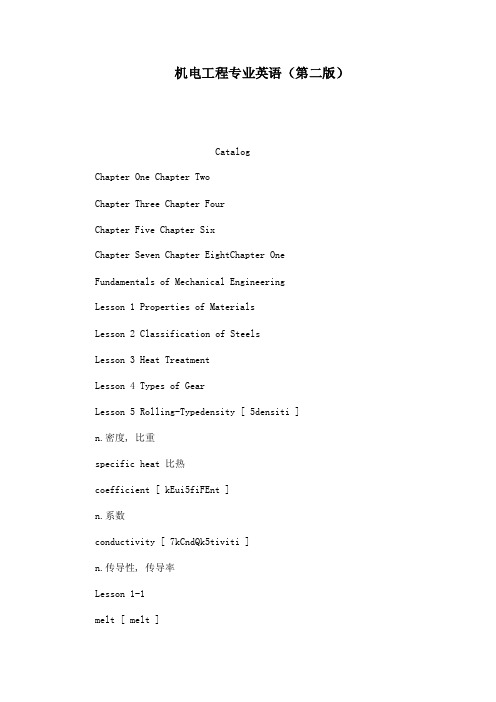
机电工程专业英语(第二版)CatalogChapter One Chapter TwoChapter Three Chapter FourChapter Five Chapter SixChapter Seven Chapter EightChapter One Fundamentals of Mechanical EngineeringLesson 1 Properties of MaterialsLesson 2 Classification of SteelsLesson 3 Heat TreatmentLesson 4 Types of GearLesson 5 Rolling-Typedensity [ 5densiti ]n.密度, 比重specific heat 比热coefficient [ kEui5fiFEnt ]n.系数conductivity [ 7kCndQk5tiviti ]n.传导性, 传导率Lesson 1-1melt [ melt ]v.使融化, 使熔化, 使软化ductility [ dQk5tiliti ]n.展延性, 柔软性toughness [ 5tQfnis ] n.韧性, 坚韧abrasion [ E5breiVEn ]n.磨损girder [ 5^E:dE ] n.桁架, 大,纵,横梁armor [ 5B:mE ]n.装甲bumper [ 5bQmpE ] n.缓冲器,减震器stamp [ stAmp ]n.邮票, 印, 图章 v. 压印, 冲压penetration [ peni5treiFEn ] n.穿过, 渗透, 突破fender [ 5fendE ]n.防卫物, 挡泥板mill [ mil ] n.磨粉机, 磨床,工厂vt.碾磨Lesson 1-11.be distinguished fromThe true is to be distinguished from the false 真假必须辨明。
(完整版)机械工程英语part2unit8
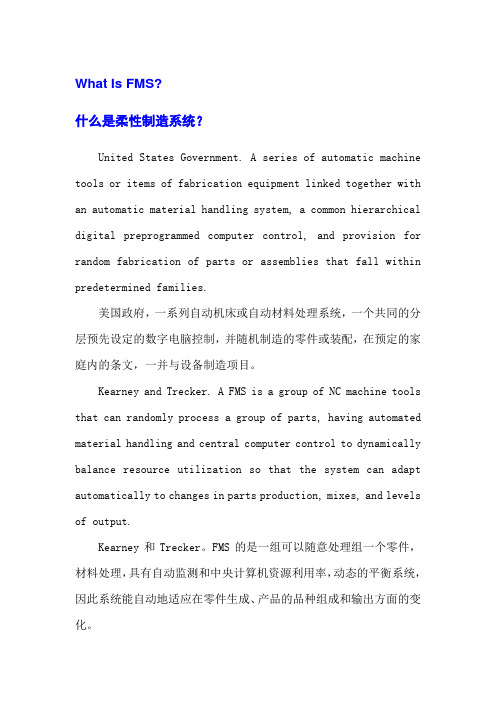
What Is FMS?什么是柔性制造系统?United States Government. A series of automatic machine tools or items of fabrication equipment linked together with an automatic material handling system, a common hierarchical digital preprogrammed computer control, and provision for random fabrication of parts or assemblies that fall within predetermined families.美国政府,一系列自动机床或自动材料处理系统,一个共同的分层预先设定的数字电脑控制,并随机制造的零件或装配,在预定的家庭内的条文,一并与设备制造项目。
Kearney and Trecker. A FMS is a group of NC machine tools that can randomly process a group of parts, having automated material handling and central computer control to dynamically balance resource utilization so that the system can adapt automatically to changes in parts production, mixes, and levels of output.Kearney和Trecker。
FMS的是一组可以随意处理组一个零件,材料处理,具有自动监测和中央计算机资源利用率,动态的平衡系统,因此系统能自动地适应在零件生成、产品的品种组成和输出方面的变化。
机电专业英语第2版8unit 8 Computer Numerical Controlled Machines
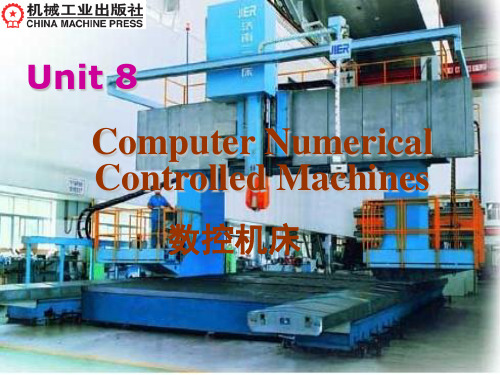
12 / 47页
第
7 / 47页
上一页
下一页
Text
机电专业英语
徐存善主编
3. Milling Machine Fig. 7-2 the vertical knee and column milling machine The milling machine has always been one of the most versatile machine tools used in industry (Fig.7-2). Operations such as milling, contouring, gear cutting, drilling, boring, and reaming are only a few of the many operations that can be performed on a milling machine4. The milling machine can be programmed on three axes: a. The X-axis controls the table movement left or right. b. The Y-axis controls the table movement toward or away from the column. c. The Z-axis controls the vertical (up and down)movement of the knee or spindle.
第
4 / 47页
上一页
下一页
Text
机电专业英语
徐存善主编
In the past, machine tools were kept as simple as possible in order to keep their costs down. Because of the ever-rising cost of labor, better machine tools, complete with electronic controls, were developed so that industry could produce more and better goods at prices that were competitive with those offshore industries. NC is being used on all types of machine tools, from the simplest to the most complex. The most common machine tools are the single-spindle drilling machine, lathe, milling machine, turning center, and machining center.
计算机专业英语第二版课后翻译答案
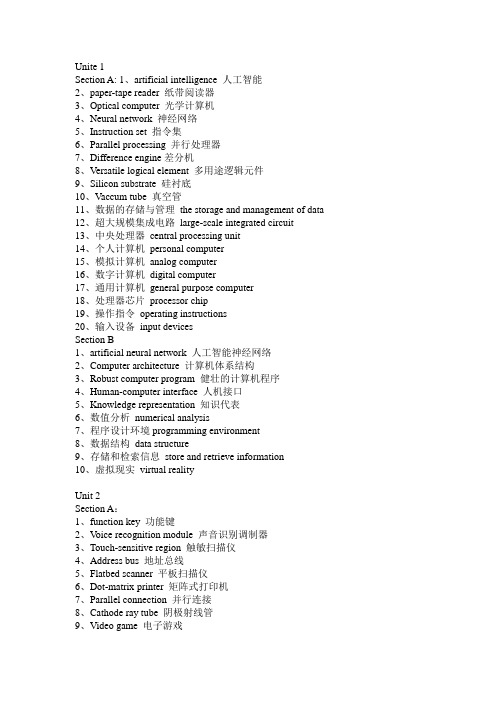
Unite 1Section A: 1、artificial intelligence 人工智能2、paper-tape reader 纸带阅读器3、Optical computer 光学计算机4、Neural network 神经网络5、Instruction set 指令集6、Parallel processing 并行处理器7、Difference engine差分机8、Versatile logical element 多用途逻辑元件9、Silicon substrate 硅衬底10、Vaccum tube 真空管11、数据的存储与管理the storage and management of data12、超大规模集成电路large-scale integrated circuit13、中央处理器central processing unit14、个人计算机personal computer15、模拟计算机analog computer16、数字计算机digital computer17、通用计算机general purpose computer18、处理器芯片processor chip19、操作指令operating instructions20、输入设备input devicesSection B1、artificial neural network 人工智能神经网络2、Computer architecture 计算机体系结构3、Robust computer program 健壮的计算机程序4、Human-computer interface 人机接口5、Knowledge representation 知识代表6、数值分析numerical analysis7、程序设计环境programming environment8、数据结构data structure9、存储和检索信息store and retrieve information10、虚拟现实virtual realityUnit 2Section A:1、function key 功能键2、V oice recognition module 声音识别调制器3、Touch-sensitive region 触敏扫描仪4、Address bus 地址总线5、Flatbed scanner 平板扫描仪6、Dot-matrix printer 矩阵式打印机7、Parallel connection 并行连接8、Cathode ray tube 阴极射线管9、Video game 电子游戏10、Audio signal 音频信号11、操作系统operating system12、液晶显示liquid crystal display13、喷墨打印机inkjet printer14、数据总线data bus15、串行连接serial connection16、易失性存储器volatile memory17、激光打印机laser printer18、磁盘存储器floppy disc19、基本输入输出系统basic input/output system20、视频显示器video displaySection B:1、interrupt handler 中断处理程序2、Virtual memory 虚拟内存3、Context switch 上下文转换4、Main memory 主存5、Bit pattern 位模式6、外围设备peripheral device7、进程表process table8、时间片time slice9、图形用户界面graphics user interface10、海量存储器mass storageUnit 3Section A:1、storage register 存储寄存器2、Function statement 函数语句3、Program statement 程序语句4、Object-oriented language 面向对象语言5、Assembly language 汇编语言6、Intermediate language 中间语言7、Relational language 关系语言8、Artificial language 人工语言9、Data declaration 数据声明10、SQL 结构化查询语言11、可执行程序executable program12、程序模块program module13、条件语句conditional statement14、赋值语句assignment statement15、逻辑语言logic statement16、机器语言machine language17、函数式语言functional language18、程序设计语言programming language19、运行计算机程序run a omputer program20、计算机程序员computer programmerSection B1、native code 本机代码2、Header file 头文件3、Multithreaded program 多线程程序4、Java-enabled browser 支持Java的浏览器5、Mallicious code6、机器码machine code7、汇编码assembly code8、特洛伊木马程序trojan9、软件包software package10、类层次class hierarchyUnit 4Section A1、inference engine 推理机2、System call 系统调用3、Compiled language 编译执行的语言4、Parellel computing 并行计算5、Pattern matching 模式匹配6、Memory location 存储单元7、Interpreter program 解释程序8、Library routine 库程序9、Intermediate program 中间程序10、Source file 源文件11、解释执行的语言interpreted language12、设备驱动程序device driver13、源程序source program14、调试程序debugger15、目标代码object code16、应用程序application program17、实用程序utility program18、逻辑程序logic program19、黑盒ink cartridge20、程序的存储与执行storage and execution of program Section B1、Messaging model 通信模式2、Common language runtime 通用语言运行时刻(环境)3、Hierarchical namespace 分层的名称空间4、Development community 开发社区5、CORBA 公共对象请求代理体系结构6、基本组件basic components7、元数据标记metadata token8、虚拟机VM virtual machine9、集成开发环境IDE(intergrated development environment)10、简单对象访问协议SOAP(simple object access protocol) Unit 5Section A1、system specification 系统规范2、Unit testing 单元测试3、Software life cycle 软件的生命周期4、System validation process 系统验证过程5、Evolutionary development process 进化发展过程6、Simple linear model 简单线性模型7、Program unit 程序单元8、Throwaway prototype 一次性使用原型9、Text formatting 文本格式10、System evolution 系统演变11、系统设计范例paradigm for system design12、需求分析与定义Requirements analysis and definition13、探索式编程方法exploratory programming approach14、系统文件编制system documentation15、瀑布模型waterfall model16、系统集成system integration17、商用现成软件commercial off-the-shelf software18、基于组件的软件工程component-based software engineering19、软件维护工具software maintenance tool20、软件复用software reuseSection B1、check box 复选框2、Structured design 结构化设计3、Building block 构建模块4、Database schema 数据库模式5、Radio button 单选按钮6、系统建模技术system modeling techniques7、模型驱动开发MDD(model-driven development)8、数据流程图data flow diagram9、下拉式菜单drop-down10、滚动条scroll barUnit 6Section A1、end user 终端用户2、Atomic operation 原子操作3、Database administrator 数据库管理员4、Relational database model 关系数据库模型5、Local data 本地数据6、Object-oriented database 面向对象的数据库7、Database management system 数据库管理系统8、Entity-relationship model 实体关系模型9、Distributed database 分布式数据库10、Flat file 展开文件11、二维表two-dimensional table12、数据属性data attributes13、数据库对象database object14、存储设备storage device15、数据类型data type16、数据插入与删除insertion and deletion17、层次数据库模型hierarchical18、数据库体系结构database architecture19、关系数据库管理系统ralational database management system20、全局控制总线global control busSection B1、nonvolatile storage system 易失性存储系统2、Equitment malfunction 设备故障3、Wound-wait protocol 损伤等待协议4、Exclusive lock 排它锁5、Database integrity 数据库完整性6、共享锁shared lock7、数据库实现database implementation8、级联回滚cascading rollback9、数据项data item10、分时操作系统time sharing operating system ;Unit 7Section A1、microwave radio 微波无线电2、digital television 数字电视3、DSL 数字用户线路4、analog transmission 模拟传输5、on-screen pointer 屏幕上的指针6、computer terminal 计算机终端7、radio telephone 无线电话8、cellular telephone 蜂窝电话,移动电话,手机9、decentralized network 分散型网络10、wire-based internal network 基于导线的内部网络,有线内部网11、光缆fiber-optic cable12、传真机fax machine13、线通信wireless communications14、点对点通信point-to-point communications15、调制电脉冲modulated electrical impulse16、通信卫星communication(s) satellite17、电报电键telegraph key18、传输媒体transmission medium (或media)19、无绳电话cordless telephone20、金属导体metal conductorSection B1、bit map 位图2、parallel port 并行端口3、direct memory access (DMA) 直接存储器存取4、universal serial bus 通用串行总线5、general-purpose register 通用寄存器6、电路板circuit board7、串行通信serial communication8、数码照相机digital camera9、存储映射输入/输出memory-mapped I/O10、有线电视cable televisionUnit 8Section A1、file server 文件服务器2、carrier sense 载波检测3、Protocol suite 协议族4、Peer-to-peer model 点对点模型5、bus topology network 总线拓扑网络6、inter-machine cooperation 计算机间合作7、Ethernet protocol collection 以太网协作集8、Proprietary network 专有网络9、utility package 实用软件包10、star network 星形网络11、局域网local area network (LAN)12、令牌环token ring13、无线网络wireless network14、封闭式网络closed network15、环形拓扑网络ring topology16、客户/服务机模型client/server model17、网络应用程序network application18、进程间通信interprocess communication19、打印服务机printer server20、广域网wide area networkSection B1、routing path 路由选择通路2、dual-ring topology 双环形拓扑结构3、extended star topology 扩展星形拓扑结构4、backbone network 基干网,骨干网5、mesh topology网络拓扑结构6、同轴电缆coaxial cable7、逻辑拓扑结构logical topology8、无冲突连网环境collision-free networking environment9、树形拓扑结构tree topology10、目的地节点destination nodeUnit 9Section A1、cell phone 蜂窝电话,移动电话,手机2、IP address 网际协议地址,IP地址3、autonomous system 自主系统4、dial-up connection 拨号连接5、network identifier 网络标识符6、binary notation 二进制记数法7、mnemonic name 助记名,缩写名8、Internet-wide directory system 因特网范围的目录系统9、name server 名称服务器10、Internet infrastructure 因特网基础结构11、助记地址mnemonic address12、网吧cyber cafe13、宽带因特网访问broadband Internet access14、顶级域名top-level domain (TLD)15、因特网编址Internet addressing16、点分十进制记数法dotted decimal notation17、因特网服务提供商Internet service provider (ISP)18、专用因特网连接dedicated Internet connection19、主机地址host address20、硬件与软件支持hardware and software support Section B1、incoming message 来报,到来的报文2、application layer 应用层3、utility software 实用软件4、sequence number (顺)序号,序列号5、remote login capabilities 远程登录能力6、端口号port number7、软件例程software routine8、传输层transport layer9、文件传送协议FTP(File Transfer Protocol)10、万维网浏览器Web browserUnit 10Section A1、mailing list 邮件发送清单,邮件列表2、proprietary software 专有软件3、cc line 抄送行4、bcc line 密送行5、forwarded e-mail messages 转发的电子邮件6、e-mail convention 电子邮件常规7、click on an icon 点击图标8、confidential document 密件,秘密文件9、classified information 密级信息10、recovered e-mail message 恢复的电子邮件11、常用情感符commonly used emoticon12、已删除电子邮件deleted e-mail13、电子系统electronic system14、附件行Attachments line15、版权法copyright law16、电子邮件网规e-mail netiquette17、信息高速公路information superhighway18、签名文件signature file19、电子数据表程序spreadsheet program20、文字处理软件word processorSection B1、web-authoring software 网络写作软件2、template generator 模版生成程序3、navigation page 导航页面4、corporate logo 公司标识5、splash page 醒目页面,过渡页6、导航条navigation bar7、节点页面node page8、网站地图site map9、可用性测试usability testing10、图形交换格式gif(Graphics Interchange Format)Unit 11Section A1、customized marketing strategy 定制的营销策略2、B2G transaction 企业对政府交易3、mobile telephone 移动电话4、dot-com bust 网络不景气5、smart card 智能卡,灵巧卡6、digital piracy 数字盗版7、dot-com boom 网络繁荣8、C2C transaction 消费者对消费者交易9、Web auction site 拍卖网站10、fingerprint reader 指纹读取器11、射频识别装置radio-frequency identification (RFID) device12、电子数据交换electronic data interchange (EDI)13、库存管理技术inventory management technology14、知识产权intellectual property15、条形码bar code16、货币兑换currency conversion17、电子图书electronic book18、视网膜扫描仪retina scanner19、个人数字助理personal digital assistant (PDA)20、企业对企业电子商务B2B electronic commerceSection B1、software suite 软件套件2、text box 文本框3、virtual checkout counter 虚拟付款台4、static catalog 静态目录5、browser session 浏览器会话期6、动态目录dynamic catalog7、购物车软件shopping cart software8、供应链supply chain9、企业资源计划软件enterprise resource planning (ERP) software10、税率tax rateUnit 12Section A1、encryption program 加密程序2、deletion command 删除命令3、authorized user 授权的用户4、backup copy 备份5、voltage surge 电压浪涌6、circuit breaker 断路器7、electronic component 电子元件(或部件)8、data-entry error 数据输入错误9、electronic break-in 电子入侵10、power line 电力线,输电线11、检测程序detection program12、电源power source13、破坏性计算机程序destructive computer program14、计算机病毒computer virus15、软件侵权software piracy16、硬盘驱动器hard-disk drive17、病毒检查程序virus checker18、主存储器primary storage19、电子公告板electronic bulletin board20、浪涌电压保护器surge protectorSection B1、phishing attack 网络钓鱼攻击2、graphics card 显(示)卡3、heuristic analysis 试探性分析4、infected file 被感染文件5、virus dictionary 病毒字典6、数据捕获data capture7、恶意软件malicious software8、病毒特征代码virus signature9、防病毒软件antivirus software10、内存驻留程序memory-resident program。
机电工程专业英语(期末考试复习资料)

一、Place a “T” before sentences that are true and an “F” before those that are false ( T )1、A worm gear is sometimes used in machines, it has low friction that can save considerable power.蜗轮有时用在机器上,具有低的摩擦,可节省相当大的力。
( T )2、In a cam mechanism, when the cam turns through one motion cycle, the follower executes a series of event consisting of rises, dwells and returns.在一个凸轮机构中,当凸轮转过一个运动周期时,从动件执行一系列由上升、停留和返回的动作。
( T )3、Integrated circuit is built on a semiconductor substrate, usually one of multi-crystal silicon.集成电路是建立在一个半导体衬底,通常是多晶硅。
( T )4、Krichhoff’s voltage law states that the sum of the potential drops around a loop in a circuit must be zero.Krichhoff电压定律指出,在电路中的回路的电位下降的总和必须为零。
( F )5、Electrons and protons are said to have the same positive charges.电子和质子具有相反的电荷。
( T )6、If a sinusoidally varying voltage source is connected across the capacitor, it can be shown that the voltage across the capacitor lags the current by in phase, meaning that the voltage peaks occur 1/4 of an oscillation period later in time relative to the current peaks.如果一个以正弦波形式随时间正负变化的电压源加在电容上,将会使电容电压在相位上滞后于电流,即该电压的峰值会比电流的峰值晚出现四分之一个周期的时间。
机电工程专业英语

1The rotor (rotating member) in an electric motor has rotational inertia, and a torque is required to bring it up to speed when the motor is started. If the motor shaft is rigidly connected to a load with a large rotational inertia, and the motor is started suddenly by closing a switch, the motor may not have sufficient torque capacity to bring the motor shaft up to speed before the windings in the motor are burned out by the excessive current demands . A clutch between the motor and the load shafts will restrict the starting torque on the motor to that required to accelerate the rotor and parts of the clutch only.电机的转子(转动元件之一)是有惯性的。
当电机启动时,需要一个力矩使转子提升速度。
如果电机轴与负荷是刚性连接,就会有更大的惯性。
这样启动,电机在还没有足够的力矩使转子提升到一定速度,可能就被过电流烧毁了线圈。
在电机和负荷之间的离合器,会限制启动转矩来保证有足够的力矩只加速转子和离合器。
有些机床,可以非常方便的在电机连续运转时,通过操作离合器来启动或停止机器的。
2To keep the parts separated, it is necessary that the pressure within the lubrication film balance the load on the sliding surfaces. If the lubricating film’s pressure is supplied by an external source, the system is said to be lubricated hydro-statically. If the pressure between the surfaces is generated as a result of the shape and motion of the surfaces themselves, however, the system is hydro-dynamically lubricated. This second type of lubrication depends upon the viscous properties of the lubricant.为了把零件隔离开,润滑膜中的压力必须和作用在滑动面上的负载(荷)保持平衡。
机电工程专业英语
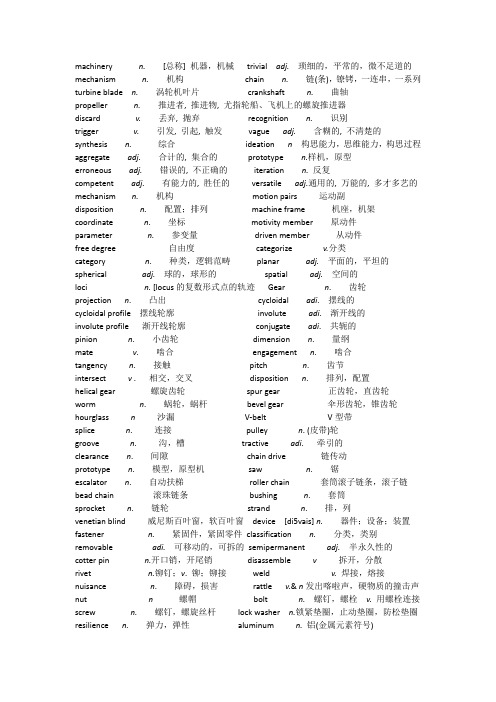
machinery n. [总称] 机器,机械trivial adj. 琐细的,平常的,微不足道的mechanism n.机构chain n.链(条),镣铐,一连串,一系列turbine blade n.涡轮机叶片crankshaft n. 曲轴propeller n. 推进者, 推进物, 尤指轮船、飞机上的螺旋推进器discard v. 丢弃, 抛弃recognition n.识别trigger v. 引发, 引起, 触发vague adj. 含糊的, 不清楚的synthesis n. 综合ideation n 构思能力,思维能力,构思过程aggregate adj.合计的, 集合的prototype n.样机,原型erroneous adj.错误的, 不正确的iteration n.反复competent adj. 有能力的, 胜任的versatile adj.通用的, 万能的, 多才多艺的mechanism n. 机构motion pairs 运动副disposition n. 配置;排列machine frame 机座,机架coordinate n. 坐标motivity member 原动件parameter n. 参变量driven member从动件free degree 自由度categorize v.分类category n. 种类,逻辑范畴planar adj.平面的,平坦的spherical adj.球的,球形的spatial adj.空间的loci n. [locus的复数形式点的轨迹Gear n. 齿轮projection n. 凸出cycloidal adi. 摆线的cycloidal profile 摆线轮廓involute adi. 渐开线的involute profile 渐开线轮廓conjugate adi. 共轭的pinion n. 小齿轮dimension n. 量纲mate v. 啮合engagement n. 啮合tangency n. 接触pitch n. 齿节intersect v . 相交,交叉disposition n. 排列,配置helical gear 螺旋齿轮spur gear 正齿轮,直齿轮worm n. 蜗轮,蜗杆bevel gear 伞形齿轮,锥齿轮hourglass n 沙漏V-belt V型带splice n. 连接pulley n. (皮带)轮groove n. 沟,槽tractive adi. 牵引的clearance n. 间隙chain drive 链传动prototype n. 模型,原型机saw n. 锯escalator n. 自动扶梯roller chain 套筒滚子链条,滚子链bead chain 滚珠链条bushing n. 套筒sprocket n. 链轮strand n. 排,列venetian blind 威尼斯百叶窗,软百叶窗device [di5vais] n. 器件;设备;装置fastener n.紧固件,紧固零件classification n.分类,类别removable adi.可移动的,可拆的semipermanent adj. 半永久性的cotter pin n.开口销,开尾销disassemble v拆开,分散rivet n.铆钉;v. 铆;铆接weld v. 焊接,熔接nuisance n. 障碍,损害rattle v.& n发出喀啦声,硬物质的撞击声nut n 螺帽bolt n. 螺钉,螺栓v. 用螺栓连接screw n. 螺钉,螺旋丝杆lock washer n.锁紧垫圈,止动垫圈,防松垫圈resilience n.弹力,弹性aluminum n. 铝(金属元素符号)shaft n. 轴bearing n.轴承,支承gear n. 齿轮cam n.凸轮,靠模clutch v.& n. 抓住,离合器cold-roll v.& n冷轧,冷轧机forge v.& n 锻造,打制flexible adj. 柔软的,适用性强friction n.摩擦brake v. 破坏,折断,损坏wear v.& n磨损,耗损arrangement n.布置,排列contaminant n.杂质,污染物质sealing arrangement n.密封装置hostility n. 敌意,恶劣appreciation n. 评价,欣赏interference n. 干涉,过盈fretting n.微振磨损corrosion n. 腐蚀abut v.邻接,倚靠stress concentration 应力集中shoulder n. 轴肩chamfer v.& n.倒角,倒圆,开槽journal bearing n.滑动轴承cylinderical adj. 圆筒状的,柱状的lubricant n. 润滑剂,润滑材料compatible adj.相适用,和谐的,一致的graphics n.制图,图学drafting n. 草图,制图drawing n. 绘图,制图,图样projection n. 投影dimension n. 尺寸;v. 给……标注尺寸spatial analysis 空间分析spatial visualization 空间想象horizontal projection 水平投影frontal projection 正投影profile projection 侧投影quadrant n. 象限center-lines of symmetry 对称中心线composite object 组合体detail drawing 零件图assembly drawing 装配图phantom line 假想线evolve v. (使)发展,(使)进展,(使)进化conceptualization n.化为概念,概念化documentation n. 文件inconsistency n. 不兼容性NC. Numerical Control数字控制CNC. Computer Numerical Control 计算机数字控制interactive adj. 交互式的wire-frame models 线框模型surface models 表面模型solid models 实体模型stress-strain 应力-应变fabricate v. 构成,伪造,虚构incorporate adj. 合并的,一体化的tolerance n.公差v.给机器部件等规定公差nominal adj.公称的,标称的,额定的intrinsic adj.固有的,内在的,本质的normal distribution 正态分布weld bead 焊缝fillet n. 圆角,倒角spigot n.插销,塞子,阀门interference fit 干涉配合,过盈配合broach n. 拉刀;v.拉削gauge n. (电线等的)直径;(金属板的)厚度;量具deviation n.偏差,偏移numerical control 数字控制instruction n. 指令binary adj. 二进制lathe n. 车床mill v. 铣drill v. 钻bore 、v. 镗grind v. 磨turret n. 转盘punch n. 冲床flame n. (电)火化wire-cutting 线切割pipe bender 弯管机spindle n. 主轴contour n. 轮廓workpiece n. 工件countersink n. 钻(沉头)孔counterbore n. 镗(沉头)孔ream n. 铰孔tapping n. 攻丝spotwelding 点焊synchronization n. 同步interpolation n. 插补parabolic adj. 抛物线的compensation n. 补偿pertain v. 合适coolant n. 冷却液clamping n. 夹紧miniaturization n. 小型化dedicated adj. 专用的forge v. 锻造eutectoid adj. 共析的austenite n. 奥氏体pearlite n. 珠光体martensitic adj. 马氏体的stress relieving 消除应力,低温退火tempering n. 回火normalizing n.常化,正火ferrous alloy 铁合金transformation n.变换,转换,相变still adj. 不动的,静止的full annealing 完全退火notably adv.显著地,特别是austenitize v. 奥氏体化,使成奥氏体denote v. 指示,表示,概述machinability n.切削加工性,机械加工性能facilitation n. 便于in-process adj. (加工、处理)过程中的qualification n.资格,条件,限制,限定quenching n. 淬火brine n. 盐水caustic adj.腐蚀性的,碱性的aqueous adj. 水的,水成的warp n.翘曲,变形glossary n.词汇表,术语汇编quench-hardened adj.淬火硬化的process annealing 工序间退火,中间退火fog quenching 喷雾淬火hot quenching 高温淬火,热淬火hydraulic system 液压系统displacement n. 位移,转移,置换layer n. 层,层次tangential adj. 切线的,切向的Newtonian adj.牛顿的,牛顿学说的nonlinear adj.非线性的,非直线的rotational adj.旋转的,转动的,循环的compressible adj.可压缩的,可压榨的Pascal’s law n.帕斯卡定律intake n. 入口,进口,进入量tank n.油箱,水箱,池塘reservoir n. 蓄水池,水箱,蓄能器atmospheric adj. 大气的,空气的discharge n.卸货,出料,流出vi.卸下放出pressurize v.增压,给……加压prehistoric adj. 史前的,很久以前的harness v.利用(风等)作动力,治理,控制watermill n. 水车,水磨mosaic n. 镶嵌细工,马赛克domestication n. 家养,驯养preference n. 优先选择compact adj. 紧凑的,紧密的简洁的diagrammatic adj. 图表的,概略的intersect v . 交叉disposition n. 排列,配置helical gear 螺旋齿轮spur gear 正齿轮worm n. 蜗轮,蜗杆bevel gear 伞形齿轮hourglass n 沙漏V-belt V型带splice n. 连接pulley n. (皮带)轮groove n. 沟,槽tractive adi.牵引的,曳引的oil pressure pump 油泵hydraulic motor 液压电机hydraulic cylinder 油缸kinetic energy 动能hydrostatic driver 静压传动variable-delivery pump 变量泵by no means 决不……self-contained adj.独立的,配套的,整体的stimulate v. 促进,激励hydraulics n. 水力学,液压系统resilience n. 跳回,恢复力,回弹virtue n. 优点,效力,功能detriment n. 损害,不利regrind v. 重磨stimulate v. 促进,激励hydraulics n. 水力学,液压系统resilience n. 跳回,恢复力,回弹virtue n 优点,效力,功能detriment n. 损害,不利regrind v重磨mechatronics 机电一体化synergetic adj.协同的,合作的fusion n. 融合Notion n. 概念,想法Interdisciplinary adj. 学科间的paradigm n范例benchmark n. 基准,标准evolutionary adj. 发展的,演化的DSP (Digital Signal Processing) 数字信号处理IC (ntegrated Circuit) 集成电路Consensus n. 一致augment v. 增加,扩大unify v成为一体,统一cornerstone n. 基石,基础reprogrammable adj. 可重复编程的,可改编的manipulate v.操作, 使用(机器等)操纵accommodate v.供应, 供给, 使适应, 调节, 容纳Monotonous adj. 单调的, 无变化的end effector n终端操作机构Elbow n. 肘wrist n. 手腕, 腕关节stretch out v.伸出,伸手, 开始大踏步走Cartesian adj.笛卡儿的cylindrical adj.圆柱的,圆筒形的,柱面的spherical adj.球状的,天体的,圆的articulated adj. 铰接的,有关节的gripper n.抓持器, 夹持器,手爪actuation n.活动,激励,动作envelope n. 封袋,[数]包迹,包络线variant n. 变量custom-made adj.定做的, 订制的payload n.有效载荷pneumatic adj.装满空气的, 气动的, 风力的discrepancy n.相差, 差异, 矛盾designate v指明, 指出, 任命, 指派servocontrol n.伺服控制, 随动控制tactile adj.触觉的, 有触觉的opportunity n.机会Delegation n.代表团spectacular adj. 壮观的negotiation n.谈判booth n. 层位,摊位catalogue n.产品样本,目录moderate adj.适中的steamer n.船contract n. 合同transit n.& v.运输cooperation n. 合作,协作manufacturing technology 制造技术opening ceremony 开幕式participate in 参加exhibition hall 展馆,展厅homemade machine tool 国产机床simultaneous five-axis CNC machine 五轴联动数控机床boring-milling machine 镗铣床unit price 单价direct steamer 直达航运Lagos n.拉各斯,尼日利亚首都direct steamer 直达航运。
机电专业英语第2版电子教案unit 8
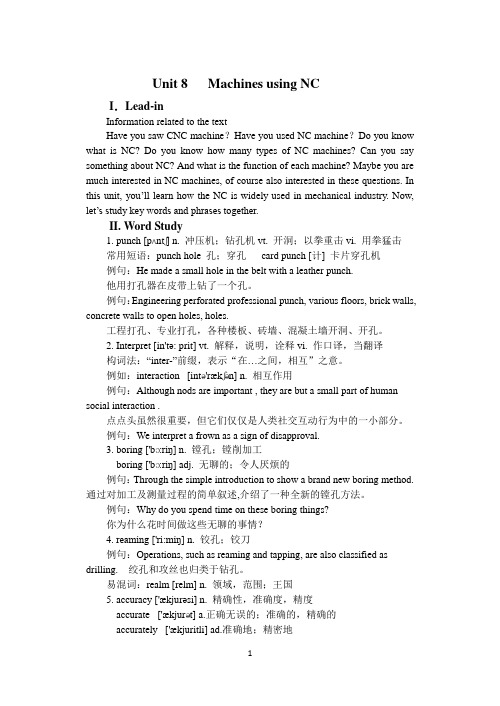
Unit 8 Machines using NCI.Lead-inInformation related to the textHave you saw CNC machine?Have you used NC machine?Do you know what is NC? Do you know how many types of NC machines? Can you say something about NC? And what is the function of each machine? Maybe you are much interested in NC machines, of course also interested in these questions. In this unit, you’ll learn how the NC is widely used in mechanical industry. Now, let’s study key words and phrases together.II. Word Study1. punch [pʌntʃ] n. 冲压机;钻孔机vt. 开洞;以拳重击vi. 用拳猛击常用短语:punch hole 孔;穿孔card punch [计] 卡片穿孔机例句:He made a small hole in the belt with a leather punch.他用打孔器在皮带上钻了一个孔。
例句:Engineering perforated professional punch, various floors, brick walls, concrete walls to open holes, holes.工程打孔、专业打孔,各种楼板、砖墙、混凝土墙开洞、开孔。
2. Interpret [in'tə: prit] vt. 解释,说明,诠释vi. 作口译,当翻译构词法:“inter-”前缀,表示“在…之间,相互”之意。
机电工程专业英语总复习资料(机械制造)

Lesson 1The major part of a machine is the mechanical system .And the mechanical system is decomposed into mechanisms ,which can be further decomposed into mechanical components .In this sense ,the mechanical components are the fundamental elements of machinery. On the whole ,mechanical components can be classified as universal and special component .Bolts ,gear ,and chains are the typical example of the universal components ,which can be used extensively in different machines across various industrial sectors .Turbine blades ,crankshaft and aircraft propeller are the examples of the special components ,which are designed for some specific purposes .机器的主要部分是机械系统,机械系统可以分解成机构,机构又可以进一步分解成机械零件。
因此,机械零件是构成机器的基本单元。
总体上来讲,机器零件可以分为通用零件和专用零件两类。
螺栓、齿轮和链条是典型的通用型零件,它们广泛应用在各种工业部门的不同机器上。
涡轮机的叶片、曲轴和飞机的螺旋桨属于专用零件,它们具有一些特殊用途。
- 1、下载文档前请自行甄别文档内容的完整性,平台不提供额外的编辑、内容补充、找答案等附加服务。
- 2、"仅部分预览"的文档,不可在线预览部分如存在完整性等问题,可反馈申请退款(可完整预览的文档不适用该条件!)。
- 3、如文档侵犯您的权益,请联系客服反馈,我们会尽快为您处理(人工客服工作时间:9:00-18:30)。
第
9 / 47页
上一页
下一页
Text
机电专业英语
徐存善主编
5. Machining Center Machining centers were developed in the 1960s so that a part did not have to be moved from machine to machine in order to perform various operations. These machines greatly increased production rates because more operations could be performed on a work-piece in one setup. There are two main types of machining centers, the horizontal and the vertical spindle types. a. The horizontal spindle-machining center operates on three axes: (a) The X-axis controls the table movement left or right. (b) The Y-axis controls the vertical movement (up and down) of the spindle. (c) The Z-axis controls the horizontal movement (in or out) of the spindle. b. The vertical spindle-machining center operates on three axes: (a) The X-axis controls the table movement left or right. (b) The Y-axis controls the table movement toward or away from the column. (c) The Z-axis controls the vertical movement (up and down) of the spindle.
第
11 / 47页
上一页
下一页
Text
New words and phrases
机电专业英语
徐存善主编
knee [ni:] n. 升降台 turning ['tə:niŋ] n. 车削 headstock ['hedstɔk] n. 主轴承 accuracy ['ækjurəsi] n. 精确性,准确度,精度 work-piece [wə:kpi:s] n. 工件 horizontal ['hɔri'zɔntəl] adj. 水平的 vertical ['və:tikəl] adj. 垂直的,直立的 production rate 生产率 numerical control (NC) 数字控制 a punched tape 穿孔纸带
Unit 8
Computer Numerical Controlled Machines
数控机床
机电专业英语
徐存善主编
CNC machines华 Nhomakorabea数控面板
上一页
数控机床
下一页
第
2 / 47页
机电专业英语
徐存善主编
CNC Machines
第
3 / 47页
上一页
下一页
Text
机电专业英语
徐存善主编
第
8 / 47页
上一页
下一页
Text
机电专业英语
徐存善主编
4. Turning Center Turning Centers were developed in the mid-1960s after studies showed that about 40 percent of all metal cutting operations were performed on lathes. These numerically controlled machines are capable of greater accuracy and higher production rates than were possible on the engine lathe. The basic turning center operates on only two axes: a. The X-axis controls the cross motion of the turret head. b. The Z-axis controls the lengthwise travel (toward or away from the headstock) of the turret head.
第
5 / 47页
上一页
下一页
Text
机电专业英语
徐存善主编
1. Single-Spindle Drilling Machine One of the simplest numerically controlled machine tools is the single-spindle drilling machine. Most drilling machines are programmed on three axes: a. The X-axis controls the table movement to the right and left. b. The Y-axis controls the table movement toward or away from the column. c. The Z-axis controls the up or down movement of the spindle to drill holes to depth.
第
6 / 47页
上一页
下一页
Text
机电专业英语
徐存善主编
2. Lathe The engine lathe, one of the most productive machine tools, has always been a very efficient means of producing round parts (Fig.7-1). Most lathes are programmed on two axes: a.The X-axis controls the cross motion (in or out) of the cutting tool. b.The Z-axis controls the carriage travel toward or away from the headstock .
第
7 / 47页
上一页
下一页
Text
机电专业英语
徐存善主编
3. Milling Machine Fig. 7-2 the vertical knee and column milling machine The milling machine has always been one of the most versatile machine tools used in industry (Fig.7-2). Operations such as milling, contouring, gear cutting, drilling, boring, and reaming are only a few of the many operations that can be performed on a milling machine4. The milling machine can be programmed on three axes: a. The X-axis controls the table movement left or right. b. The Y-axis controls the table movement toward or away from the column. c. The Z-axis controls the vertical (up and down)movement of the knee or spindle.
第
12 / 47页
Unit 8 CNC machines
Early machines tools were operated by craftsmen who decided many variables such as speeds, feeds, and depth of cut, etc1. With the development of science and technology, a new term, numerical control (NC) appeared. Controlling a machine tool using a punched tape or stored program is known as numerical control (NC). NC has been defined by the Electronic Industries Association (EIA) as “A system in which actions are controlled by the direct insertion of numerical data at some point. The system must automatically interpret at least some portion of this datadj.”..
第
10 / 47页
上一页
下一页
